Frankfurt
| Frankfurt am Main | ||||||
|---|---|---|---|---|---|---|
| ||||||
| ||||||
 Frankfurt am Main | ||||||
Location of Frankfurt am Main within Hessen  | ||||||
| Coordinates: 50°7′N 8°41′E / 50.117°N 8.683°ECoordinates: 50°7′N 8°41′E / 50.117°N 8.683°E | ||||||
| Country | Germany | |||||
| State | Hesse | |||||
| Admin. region | Darmstadt | |||||
| District | Urban district | |||||
| Founded | 1st century | |||||
| Government | ||||||
| • Lord Mayor | Peter Feldmann (SPD) | |||||
| • Governing parties | CDU / SPD / Greens | |||||
| Area | ||||||
| • City | 248.31 km2 (95.87 sq mi) | |||||
| Population (2015-12-31)[1] | ||||||
| • City | 732,688 | |||||
| • Density | 3,000/km2 (7,600/sq mi) | |||||
| • Urban | 2,221,910[2] | |||||
| • Metro | 5,500,000[3] | |||||
| Time zone | CET/CEST (UTC+1/+2) | |||||
| Postal codes | 60001–60599, 65901–65936 | |||||
| Dialling codes | 069, 06109, 06101 | |||||
| Vehicle registration | F | |||||
| Website | www.frankfurt.de | |||||
Frankfurt am Main (German pronunciation: [ˈfʁaŋkfʊɐ̯t am ˈmaɪ̯n]) is a metropolis and the largest city in the German state of Hesse and the fifth-largest city in Germany, with a 2015 population of 731,095 within its administrative boundaries,[4] and 2.3 million in its urban area.[2][5] The city is at the centre of the larger Frankfurt Rhine-Main Metropolitan Region, which has a population of 5.8 million[3] and is Germany's second-largest metropolitan region after Rhine-Ruhr. Since the enlargement of the European Union in 2013, the geographic centre of the EU is about 40 km (25 mi) to the east of Frankfurt's CBD, the Bankenviertel.
Frankfurt is an alpha world city and a global hub for commerce, culture, education, tourism and traffic. Frankfurt Airport is among the world's busiest. Frankfurt is the major financial centre of the European continent, with the HQs of the European Central Bank, German Federal Bank, Frankfurt Stock Exchange, Deutsche Bank, Commerzbank, DZ Bank, KfW, several cloud and fintech startups and other institutes. Frankfurt's DE-CIX is the world's largest internet exchange point. Messe Frankfurt is one of the world's largest trade fairs. Major fairs include the Frankfurt Motor Show, the world's largest motor show, and the Frankfurt Book Fair, the world's largest book fair.
Frankfurt is home to many cultural and educational institutions, including the Goethe University, the UAS and various graduate schools like the Frankfurt School of Finance & Management, the Alte Oper, many museums (e.g., Städel, Senckenberg Natural Museum, Liebieghaus, Goethe House), the Schirn art venue at the old town, and two major botanical gardens: the Palmengarten and the University's Botanical Garden. In sports, the city is known as the home of the top tier football club Eintracht Frankfurt, the basketball club Frankfurt Skyliners and the venue of Ironman Germany. Frankfurt is culturally and ethnically diverse, with around half of the population, and a majority of young people, having an immigrant background. A quarter of the population are foreign nationals, including many expatriates.
Distinctions
Frankfurt is the largest financial centre in continental Europe. It is home to the European Central Bank, Deutsche Bundesbank, Frankfurt Stock Exchange and several large commercial banks.
The Frankfurt Stock Exchange is one of the world's largest stock exchanges by market capitalization and accounts for more than 90 percent of the turnover in the German market.
In 2010, 63 national and 152 international banks had their registered offices in Frankfurt, including Germany's major banks, notably Deutsche Bank, Commerzbank, DZ Bank and KfW, as well as 41 representative offices of international banks.[6]
Frankfurt is considered a global city (alpha world city) as listed by the GaWC group's 2012 inventory.[7] Among global cities it was ranked 10th by the Global Power City Index 2011 and 11th by the Global City Competitiveness Index 2012. Among financial centres it was ranked 8th by the International Financial Centers Development Index 2013 and 9th by the Global Financial Centres Index 2013.
Its central location within Germany and Europe makes Frankfurt a major air, rail and road transport hub. Frankfurt Airport is one of the world's busiest international airports by passenger traffic and the main hub for Germany's flag carrier Lufthansa. Frankfurt Central Station is one of the largest rail stations in Europe and the busiest junction operated by Deutsche Bahn, the German national railway company, with 342 trains a day to domestic and European destinations.[8] Frankfurter Kreuz, the Autobahn interchange close to the airport, is the most heavily used interchange in the EU, used by 320,000 cars daily.[9] In 2011 human-resource-consulting firm Mercer ranked Frankfurt as seventh in its annual 'Quality of Living' survey of cities around the world.[10] According to The Economist cost-of-living survey, Frankfurt is Germany's most expensive city and the world's 10th most expensive.[11]
Frankfurt has many high-rise buildings in the city centre, forming the Frankfurt skyline. It is one of the few cities in the European Union to have such a skyline and because of it Germans sometimes refer to Frankfurt as Mainhattan, a portmanteau of the local Main River and Manhattan. The other well known and obvious nickname is Bankfurt. Before World War II the city was globally noted for its unique old town with timber-framed buildings, the largest timber-framed old town in Europe. The Römer area was later rebuilt and is popular with visitors and for events such as Christmas markets. Other parts of the old town are to be reconstructed as part of the Dom-Römer Project by 2016.
Etymology
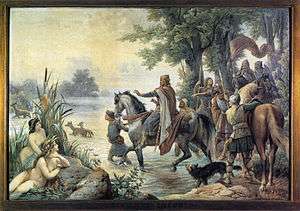
Frankonovurd (in Old High German) or Vadum Francorum (in Latin) were the first names mentioned in written records from 794. It transformed to Frankenfort during the Middle Ages and then to Franckfort and Franckfurth in the modern era. According to Czech historian Dovid Solomon Ganz, the city was named circa 146 CE by its builder, a Frankish king named Zuna, who ruled over the province then known as Sicambri. He hoped thereby to perpetuate the name of his lineage.[12] The name is derived from the Franconofurd of the Germanic tribe of the Franks; Furt (cf. English 'ford) where the river was shallow enough to be crossed on foot.
By the 19th century, the name Frankfurt had been established as the official spelling. The older English spelling of Frankfort is now rarely seen in reference to Frankfurt am Main, although more than a dozen other towns and cities, mainly in the United States, use this spelling (e.g., Frankfort, Kentucky; Frankfort, New York; Frankfort, Illinois).
The suffix 'am Main' has been used regularly since the 14th century. In English, the city's full name of Frankfurt am Main means 'Frankfurt on the Main' (pronounced like English 'mine' or German mein). Frankfurt is located on an ancient ford (German: Fort) on the Main River. As a part of early Franconia, the inhabitants were the early Franks, thus the city's name reveals its legacy as "the ford of the Franks on the Main".[13]
Among English speakers, the city is commonly known simply as Frankfurt, but Germans occasionally call it by its full name to distinguish it from the other (significantly smaller) German city of Frankfurt an der Oder in the federated state of Brandenburg on the Polish border.
The city district Bonames has a name probably dating back to Roman times, thought to be derived from bona me(n)sa (good table).
The common abbreviations for the city, primarily used in railway services and on road signs, are Frankfurt (Main), Frankfurt (M), Frankfurt a.M., Frankfurt/Main or Frankfurt/M. The common abbreviation for the name of the city is "FFM". Also in use is "FRA", the IATA code for Frankfurt Airport.
History
Roman settlements were established in the area of the Römer, probably in the first century. Nida (Heddernheim) was also a Roman civitas capital.
Alemanni and Franks lived there, and by 794, Charlemagne presided over an imperial assembly and church synod, at which Franconofurd (alternative spellings end with -furt and -vurd) was first mentioned.
Frankfurt was one of the most important cities in the Holy Roman Empire. From 855, the German kings and emperors were elected and crowned in Aachen. From 1562, the kings and emperors were crowned in Frankfurt, initiated for Maximilian II. This tradition ended in 1792, when Franz II was elected. His coronation was deliberately held on Bastille Day, 14 July, the anniversary of the storming of the Bastille. The elections and coronations took place in St. Bartholomäus Cathedral, known as the Kaiserdom (Emperor's Cathedral), or its predecessors.
The Frankfurter Messe (Frankfurt Trade Fair) was first mentioned in 1150. In 1240, Emperor Friedrich II granted an imperial privilege to its visitors, meaning they would be protected by the empire. The fair became particularly important when similar fairs in French Beaucaire lost attraction around 1380. Book trade fairs began in 1478.
In 1372, Frankfurt became a Reichsstadt (Imperial Free City), i.e., directly subordinate to the Holy Roman Emperor and not to a regional ruler or a local nobleman.
In 1585, Frankfurt traders established a system of exchange rates for the various currencies that were circulating to prevent cheating and extortion. Therein lay the early roots for the Frankfurt Stock Exchange.
Frankfurt managed to remain neutral during the Thirty Years' War, but suffered from the bubonic plague that refugees brought to the city. After the war, Frankfurt regained its wealth.



In the Napoleonic Wars, Frankfurt was occupied or bombarded several times by French troops. It remained a free city until the collapse of the Holy Roman Empire in 1805/6. In 1806, it became part of the principality of Aschaffenburg under the Fürstprimas (Prince-Primate), Karl Theodor Anton Maria von Dalberg. This meant that Frankfurt was incorporated into the confederation of the Rhine. In 1810, Dalberg adopted the title of a Grand Duke of Frankfurt. Napoleon intended to make his adopted son Eugène de Beauharnais, already Prince de Venise ("prince of Venice", a newly established primogeniture in Italy), Grand Duke of Frankfurt after Dalberg's death (since the latter as a Catholic bishop had no legitimate heirs). The Grand Duchy remained a short episode lasting from 1810 to 1813, when the military tide turned in favour of the Anglo-Prussian lead allies that overturned the Napoleonic order. Dalberg abdicated in favour of Eugène de Beauharnais, which of course was only a symbolic action, as the latter effectively never ruled after the ruin of the French armies and Frankfurt's takeover by the allies.
After Napoleon's final defeat and abdication, the Congress of Vienna (1814–1815) dissolved the grand-duchy, and Frankfurt entered the newly founded German Confederation (till 1866) as a free city, becoming the seat of its Bundestag, the confederal parliament where the nominally presiding Habsburg Emperor of Austria was represented by an Austrian "presidential envoy".
After the ill-fated revolution of 1848, Frankfurt was the seat of the first democratically elected German parliament, the Frankfurt Parliament, which met in the Frankfurter Paulskirche (St. Paul's Church) and was opened on 18 May 1848. The institution failed in 1849 when the Prussian king declared that he would not accept "a crown from the gutter". In the year of its existence, the assembly developed a common constitution for a unified Germany, with the Prussian king as its monarch.

Frankfurt lost its independence after the Austro-Prussian War in 1866 when Prussia annexed several smaller states, among them the Free City of Frankfurt. Frankfurt had stayed neutral in the war, but its free press bothered the Prussians and they used the opportunity to occupy the city by force: Bismarck had been an ambassador to the German Confederation there and constantly quarrelled with the local press. The Prussian administration incorporated Frankfurt into its province of Hesse-Nassau. The formerly independent towns of Bornheim and Bockenheim were incorporated in 1890.
In 1914, the citizens founded the University of Frankfurt, later named Goethe University Frankfurt. This marked the only civic foundation of a university in Germany; today it is one of Germany's largest.
From 6 April to 17 May 1920, following military intervention to put down the Ruhr Uprising, Frankfurt was occupied by French troops.[14] The French claimed that Articles 42 to 44 of the peace treaty of Versailles concerning the demilitarisation of the Rhineland had been broken.[15] In 1924, Ludwig Landmann became the first Jewish mayor of the city, and led a significant expansion during the following years. During the Nazi era, the synagogues of the city were destroyed.
Frankfurt was severely bombed in World War II (1939–1945). About 5,500 residents were killed during the raids, and the once-famous medieval city centre, by that time the largest in Germany, was almost completely destroyed. It became a ground battlefield on 26 March 1945, when the Allied advance into Germany was forced to take the city in contested urban combat that included a river assault. The 5th Infantry Division and the 6th Armored Division of the United States Army captured Frankfurt after several days of intense fighting, and it was declared largely secure on 29 March 1945.[16]
After the end of the war, Frankfurt became a part of the newly founded state of Hesse, consisting of the old Hesse-(Darmstadt) and the Prussian Hesse provinces. The city was part of the American Zone of Occupation of Germany. The Military Governor for the United States Zone (1945–1949) and the United States High Commissioner for Germany (HICOG) (1949–1952) had their headquarters in the IG Farben Building, intentionally left undamaged by the Allies' wartime bombardment.
Frankfurt was the original choice for the provisional capital city of the newly founded state of West Germany in 1949. The city constructed a parliament building that was never used for its intended purpose (it housed the radio studios of Hessischer Rundfunk). In the end, Konrad Adenauer, the first postwar Chancellor, preferred the town of Bonn, for the most part because it was close to his hometown, but also because many other prominent politicians opposed the choice of Frankfurt out of concern that Frankfurt would be accepted as the permanent capital, thereby weakening the West German population's support for a reunification with East Germany and the eventual return of the capital to Berlin.
Postwar reconstruction took place in a sometimes simple modern style, thus changing Frankfurt's architectural face. A few landmark buildings were reconstructed historically, albeit in a simplified manner (e.g., Römer, St. Paul's Church, and Goethe House). The collection of historically significant Cairo Genizah documents of the Municipal Library was destroyed by the bombing. According to Arabist and Genizah scholar S.D. Goitein, "not even handlists indicating its contents have survived."[17]
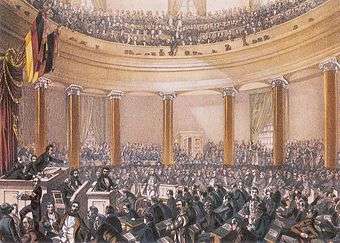
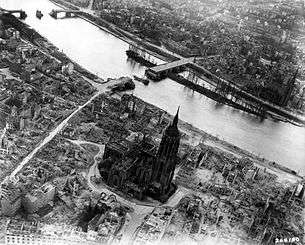
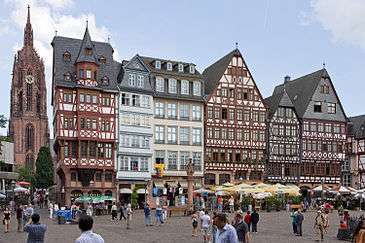
The end of the war marked Frankfurt's comeback as Germany's leading financial centre, mainly because Berlin, now a city divided into four sectors, could no longer rival it. In 1948, the allies founded the Bank deutscher Länder, the forerunner of Deutsche Bundesbank. Following this decision, more financial institutions were re-established, e.g. Deutsche Bank and Dresdner Bank. In the 1950s, Frankfurt Stock Exchange regained its position as the country's leading stock exchange.
Frankfurt also re-emerged as Germany's transportation centre and Frankfurt Airport became Europe's second-busiest airport behind London Heathrow Airport in 1961.
During the 1970s, the city created one of Europe's most efficient underground transportation systems. That system includes a suburban rail system (S-Bahn) linking outlying communities with the city centre, and a deep underground light rail system with smaller coaches (U-Bahn) also capable of travelling above ground on rails.
In 1998, the European Central Bank was founded in Frankfurt, followed by the European Insurance and Occupational Pensions Authority and European Systemic Risk Board in 2011.
Geography
It is the largest city in the federated state of Hesse in the south-western part of Germany.
Site
Frankfurt is located on both sides of the Main River, south-east of the Taunus mountain range. The southern part of the city contains the Frankfurt City Forest, Germany's largest city forest. The city area is 248.31 km2 (95.87 sq mi) and extends over 23.4 km (14.54 mi) east to west and 23.3 km (14.48 mi) north to south. The city centre is north of the River Main in Altstadt district (the historical centre) and the surrounding Innenstadt district. The geographical centre is in Bockenheim district near Frankfurt West station.
Frankfurt is the centre of the densely populated Frankfurt Rhine-Main Metropolitan Region with a population of 5.5 million. Other important cities in the region are Wiesbaden (capital of Hessen), Mainz (capital of Rhineland-Palatinate), Darmstadt, Offenbach am Main, Hanau, Aschaffenburg, Bad Homburg vor der Höhe, Rüsselsheim, Wetzlar and Marburg.
Districts

The city is divided into 46 city districts (Stadtteile), which are in turn divided into 118 city boroughs (Stadtbezirke) and 448 electoral districts (Wahlbezirke). The 46 city districts combine into 16 area districts (Ortsbezirke), which each have a district committee and chairperson.
The largest city district by population and area is Sachsenhausen, while the smallest is Altstadt, Frankfurt's historical center. Three larger city districts (Sachsenhausen, Westend and Nordend) are divided for administrative purposes into a northern (-Nord) and a southern (-Süd) part, respectively a western (-West) and an eastern (-Ost) part, but are generally considered as one city district (which is why often only 43 city districts are mentioned, even on the City's official website).[18]
Some larger housing areas are often falsely called city districts, even by locals, like Nordweststadt (part of Niederursel, Heddernheim and Praunheim), Goldstein (part of Schwanheim), Riedberg (part of Kalbach-Riedberg) and Europaviertel (part of Gallus). The Bankenviertel (banking district), Frankfurt's financial district, is also not an administrative city district (it covers parts of the western Innenstadt district, the southern Westend district and the eastern Bahnhofsviertel district).
Many city districts are incorporated suburbs (Vororte), or were previously independent cities, such as Höchst. Some like Nordend and Westend arose during the rapid growth of the city in the Gründerzeit following the Unification of Germany, while others were formed from territory which previously belonged to other city district(s), such as Dornbusch and Riederwald.
History of incorporations
Until the year 1877 the city's territory consisted of the present-day inner-city districts of Altstadt, Innenstadt, Bahnhofsviertel, Gutleutviertel, Gallus, Westend, Nordend, Ostend and Sachsenhausen.
Bornheim was part of an administrative district called Landkreis Frankfurt, before becoming part of the city on 1 January 1877, followed by Bockenheim on 1 April 1895. Seckbach, Niederrad and Oberrad followed on 1 July 1900. The Landkreis Frankfurt was finally dispersed on 1 April 1910, and therefore Berkersheim, Bonames, Eckenheim, Eschersheim, Ginnheim, Hausen, Heddernheim, Niederursel, Praunheim, Preungesheim and Rödelheim joined the City. In the same year a new city district, Riederwald, was created on territory that had formerly belonged to Seckbach and Ostend.
On 1 April 1928 the City of Höchst became part of Frankfurt, as well as its city districts Sindlingen, Unterliederbach and Zeilsheim. Simultaneously the Landkreis Höchst was dispersed with its member cities either joining Frankfurt (Fechenheim, Griesheim, Nied, Schwanheim, Sossenheim) or joining the newly established Landkreis of Main-Taunus-Kreis.
Dornbusch became a city district in 1946. It was created on territory that had formerly belonged to Eckenheim and Ginnheim.
On 1 August 1972 Hesse's smaller suburbs of Harheim, Kalbach, Nieder-Erlenbach, and Nieder-Eschbach became districts while other neighbouring suburbs chose to join the Main-Taunus-Kreis, the Landkreis Offenbach, the Kreis Groß-Gerau, the Hochtaunuskreis, the Main-Kinzig-Kreis or the Wetteraukreis.
Bergen-Enkheim was the last suburb to become part of Frankfurt on 1 January 1977.
Flughafen became an official city district in 1979. It covers the area of Frankfurt Airport that had belonged to Sachsenhausen and the neighbouring city of Mörfelden-Walldorf.
Frankfurt's youngest city district is Frankfurter Berg. It was part of Bonames until 1996.
Kalbach was officially renamed Kalbach-Riedberg in 2006 because of the large residential housing development in the area known as Riedberg.
Neighbouring districts and cities
To the west Frankfurt borders the administrative district (Landkreis) of Main-Taunus-Kreis with towns such as Hattersheim am Main, Kriftel, Hofheim am Taunus, Kelkheim (Taunus), Liederbach am Taunus, Sulzbach (Taunus), Schwalbach am Taunus and Eschborn; to the northwest the Hochtaunuskreis with Steinbach (Taunus), Oberursel (Taunus) and Bad Homburg vor der Höhe; to the north the Wetteraukreis with Karben and Bad Vilbel; to the northeast the Main-Kinzig-Kreis with Niederdorfelden and Maintal; to the southeast the city of Offenbach am Main; to the south the Kreis Offenbach with Neu-Isenburg and to the southwest the Kreis Groß-Gerau with Mörfelden-Walldorf, Rüsselsheim and Kelsterbach.
Together with these towns (and some larger nearby towns, e.g., Hanau, Rodgau, Dreieich, Langen) Frankfurt forms a contiguous built-up urban area called Stadtregion Frankfurt which is not an official administrative district. The urban area had an estimated population of 2.3 million in 2010 and is therefore the 13th largest urban area in the European Union.
Climate
Frankfurt has a temperate-oceanic climate (Köppen: Cfb). Its average annual temperature is 10.6 °C (51.1 °F), with monthly mean temperatures ranging from 1.6 °C (34.9 °F) in January to 20.0 °C (68.0 °F) in July.
| Climate data for Frankfurt Airport, Germany for 1981–2010 (Source: DWD) | |||||||||||||
|---|---|---|---|---|---|---|---|---|---|---|---|---|---|
| Month | Jan | Feb | Mar | Apr | May | Jun | Jul | Aug | Sep | Oct | Nov | Dec | Year |
| Record high °C (°F) | 15.3 (59.5) |
17.5 (63.5) |
24.2 (75.6) |
28.3 (82.9) |
32.0 (89.6) |
37.5 (99.5) |
38.8 (101.8) |
39.6 (103.3) |
31.6 (88.9) |
28.0 (82.4) |
18.9 (66) |
16.3 (61.3) |
39.6 (103.3) |
| Average high °C (°F) | 4.2 (39.6) |
5.9 (42.6) |
10.7 (51.3) |
15.4 (59.7) |
20.0 (68) |
23.1 (73.6) |
25.5 (77.9) |
25.1 (77.2) |
20.3 (68.5) |
14.6 (58.3) |
8.4 (47.1) |
4.9 (40.8) |
14.8 (58.6) |
| Daily mean °C (°F) | 1.6 (34.9) |
2.4 (36.3) |
6.4 (43.5) |
10.3 (50.5) |
14.7 (58.5) |
17.8 (64) |
20.0 (68) |
19.5 (67.1) |
15.2 (59.4) |
10.4 (50.7) |
5.6 (42.1) |
2.5 (36.5) |
10.6 (51.1) |
| Average low °C (°F) | −1.1 (30) |
−1.1 (30) |
2.1 (35.8) |
4.9 (40.8) |
9.1 (48.4) |
12.3 (54.1) |
14.4 (57.9) |
14.0 (57.2) |
10.5 (50.9) |
6.6 (43.9) |
2.8 (37) |
−0.1 (31.8) |
6.2 (43.2) |
| Record low °C (°F) | −19.1 (−2.4) |
−18.5 (−1.3) |
−12.7 (9.1) |
−7.1 (19.2) |
−1.2 (29.8) |
3.6 (38.5) |
2.8 (37) |
5.0 (41) |
0.4 (32.7) |
−4.3 (24.3) |
−9.0 (15.8) |
−16.9 (1.6) |
−19.1 (−2.4) |
| Average precipitation mm (inches) | 44.5 (1.752) |
40.9 (1.61) |
48.4 (1.906) |
42.1 (1.657) |
63.4 (2.496) |
58.1 (2.287) |
64.7 (2.547) |
56.5 (2.224) |
53.0 (2.087) |
54.7 (2.154) |
49.1 (1.933) |
53.9 (2.122) |
629.18 (24.7709) |
| Mean monthly sunshine hours | 50 | 80 | 121 | 178 | 211 | 219 | 233 | 219 | 156 | 103 | 51 | 41 | 1,662 |
| Source: Data derived from Deutscher Wetterdienst[19] | |||||||||||||
Demographics
Population


With a population of 731,095 (2015) within its administrative boundaries[4] and of 2,500,000 in the actual urban area,[5] Frankfurt is the fifth largest city in Germany after Berlin, Hamburg, Munich and Cologne. The city is considered a multicultural city because it is home to people of 180 nationalities. In addition to the ethnic German majority, the city contains sizable immigrant populations from Turkey, Afghanistan, Italy, Croatia, Serbia, Poland, Greece, Macedonia, Russia, Bulgaria, Lebanon, Romania, Bosnia and Herzegovina, Spain, Portugal, France, China, Japan, the United States, Austria, the United Kingdom, Pakistan, Morocco and India. The Frankfurt urban area is also home to the second-largest Korean community in Europe, and to Germany's largest Sri Lankan Tamil community. Nearly 25 percent of residents are foreign nationals. In addition, 40 percent of residents, and 65 percent of those below the age of five, come from immigrant backgrounds.[20]
Central Frankfurt has been a Großstadt (a city with at least 100,000 residents by definition) since 1875. With 414,576 residents in 1910, it was the ninth largest city in Germany and the number of inhabitants grew to 553,464 before World War II. After the war, at the end of the year 1945, the number had dropped to 358,000. In the following years the population grew again and reached an all-time-high of 691,257 in 1963. It dropped again to 592,411 in 1986 but has increased since then. According to the demographic forecasts for central Frankfurt, the city will have a population up to 825,000 within its administrative boundaries in 2020 and more than 2.5 million inhabitants in its urban area.
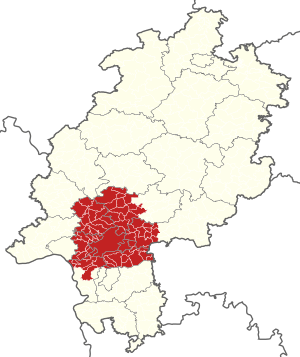
During the 1970s the state government of Hesse wanted to include the entire urban area into its administrative boundaries. This would have made Frankfurt officially the second largest city in Germany after Berlin with up to 3 million inhabitants.[21] However, because local authorities did not agree the administrative territory is still much smaller than its actual urban area.
| Largest groups of foreign residents[22] | |
| Nationality | Population (2014) |
|---|---|
| 27,100 | |
| 14,608 | |
| 13,873 | |
| 13,769 | |
| 9,054 | |
| 8,924 | |
| 6,903 | |
| 6,798 | |
| 6,524 | |
| 5,803 | |
Population by districts

| No | City district (Stadtteil) | Area in km²[23] | Population[24] | Foreign nationals[24] | Foreign nationals in %[24] | Area district (Ortsbezirk) |
|---|---|---|---|---|---|---|
| 1 | Altstadt | 0.51 km² | 3.475 | 1.122 | 32.3% | 01 – Innenstadt I |
| 2 | Innenstadt | 1.52 km² | 6.577 | 2.529 | 38.5% | 01 – Innenstadt I |
| 3 | Bahnhofsviertel | 0.53 km² | 2.125 | 810 | 38.1% | 01 – Innenstadt I |
| 4 | Westend-Süd | 2.47 km² | 17.288 | 3.445 | 19.9% | 02 – Innenstadt II |
| 5 | Westend-Nord | 1.67 km² | 8.854 | 2.184 | 24.7% | 02 – Innenstadt II |
| 6 | Nordend-West | 3.07 km² | 28.808 | 5.162 | 17.9% | 03 – Innenstadt III |
| 7 | Nordend-Ost | 1.69 km² | 26.619 | 5.580 | 21.0% | 03 – Innenstadt III |
| 8 | Ostend | 5.40 km² | 26.955 | 7.213 | 26.8% | 04 – Bornheim/Ostend |
| 9 | Bornheim | 2.66 km² | 27.184 | 6.240 | 23.0% | 04 – Bornheim/Ostend |
| 10 | Gutleutviertel | 2.20 km² | 5.843 | 1.953 | 33.4% | 01 – Innenstadt I |
| 11 | Gallus | 4.22 km² | 26.716 | 11.012 | 41.2% | 01 – Innenstadt I |
| 12 | Bockenheim | 8.04 km² | 34.740 | 9.034 | 26.0% | 02 – Innenstadt II |
| 13 | Sachsenhausen-Nord | 4.24 km² | 30.374 | 6.507 | 21.4% | 05 – Süd |
| 14 | Sachsenhausen-Süd | 34.91 km² | 26.114 | 4.847 | 18.6% | 05 – Süd |
| 15 | Flughafen | 20.00 km² | 211 | 14 | 6.6% | 05 – Süd |
| 16 | Oberrad | 2.74 km² | 12.828 | 3.113 | 24.3% | 05 – Süd |
| 17 | Niederrad | 2.93 km² | 22.954 | 6.569 | 28.6% | 05 – Süd |
| 18 | Schwanheim | 17.73 km² | 20.162 | 3.532 | 17.5% | 06 – West |
| 19 | Griesheim | 4.90 km² | 22.648 | 8.029 | 35.5% | 06 – West |
| 20 | Rödelheim | 5.15 km² | 17.841 | 4.863 | 27.3% | 07 – Mitte-West |
| 21 | Hausen | 1.26 km² | 7.178 | 2.135 | 29.7% | 07 – Mitte-West |
| 22/23 | Praunheim | 4.55 km² | 15.761 | 3.197 | 20.3% | 07 – Mitte-West |
| 24 | Heddernheim | 2.49 km² | 16.443 | 3.194 | 19.4% | 08 – Nord-West |
| 25 | Niederursel | 7.22 km² | 16.394 | 3.671 | 22.4% | 08 – Nord-West |
| 26 | Ginnheim | 2.73 km² | 16.444 | 4.024 | 24.5% | 09 – Mitte-Nord |
| 27 | Dornbusch | 2.38 km² | 18.511 | 3.482 | 18.8% | 09 – Mitte-Nord |
| 28 | Eschersheim | 3.34 km² | 14.808 | 2.657 | 17.9% | 09 – Mitte-Nord |
| 29 | Eckenheim | 2.23 km² | 14.277 | 3.674 | 25.7% | 10 – Nord-Ost |
| 30 | Preungesheim | 3.74 km² | 13.568 | 3.442 | 25.4% | 10 – Nord-Ost |
| 31 | Bonames | 1.24 km² | 6.362 | 1.288 | 20.2% | 10 – Nord-Ost |
| 32 | Berkersheim | 3.18 km² | 3.400 | 592 | 17.4% | 10 – Nord-Ost |
| 33 | Riederwald | 1.04 km² | 4.911 | 1.142 | 23.3% | 11 – Ost |
| 34 | Seckbach | 8.04 km² | 10.194 | 1.969 | 19.3% | 11 – Ost |
| 35 | Fechenheim | 7.18 km² | 16.061 | 5.635 | 35.1% | 11 – Ost |
| 36 | Höchst | 4.73 km² | 13.888 | 5.279 | 38.0% | 06 – West |
| 37 | Nied | 3.82 km² | 17.829 | 5.224 | 29.3% | 06 – West |
| 38 | Sindlingen | 3.98 km² | 9.032 | 2.076 | 23.0% | 06 – West |
| 39 | Zeilsheim | 5.47 km² | 11.984 | 2.555 | 21.3% | 06 – West |
| 40 | Unterliederbach | 5.85 km² | 14.350 | 3.511 | 24.5% | 06 – West |
| 41 | Sossenheim | 5.97 km² | 15.853 | 4.235 | 26.7% | 06 – West |
| 42 | Nieder-Erlenbach | 8.34 km² | 4.629 | 496 | 10.7% | 13 – Nieder-Erlenbach |
| 43 | Kalbach-Riedberg | 6.90 km² | 8.482 | 1.279 | 15.1% | 12 – Kalbach-Riedberg |
| 44 | Harheim | 5.02 km² | 4.294 | 446 | 10.4% | 14 – Harheim |
| 45 | Nieder-Eschbach | 6.35 km² | 11.499 | 1.978 | 17.2% | 15 – Nieder-Eschbach |
| 46 | Bergen-Enkheim | 12.54 km² | 17.954 | 2.764 | 15.4% | 16 – Bergen-Enkheim |
| 47 | Frankfurter Berg | 2.16 km² | 7.149 | 1.715 | 24.0% | 10 – Nord-Ost |
| Frankfurt am Main | 248.33 km² | 679.571 | 165.418 | 24.3% |
Religion
Frankfurt was historically a Protestant-dominated city. However, during the 19th century an increasing number of Catholics moved there. The Jewish community has a history dating back to Medieval times and has always ranked among the largest in Germany. Two synagogues operate there. Due to the growing immigration of people from Muslim countries beginning in the 1960s, Frankfurt has a large Muslim community. The Ahmadiyya Noor Mosque, constructed in 1959, is the city's largest mosque and the third largest in Germany.[25]
As of 2013 the largest Christian denominations were Roman Catholicism (22.7% of the population) and Protestantism (19.4%).[26] Estimations put the share of Muslim inhabitants at approximately 16% (2006).[27] Over 7,000 inhabitants were affiliated with the Jewish community, amounting to approximately 1% of the population.[28]
Politics

Frankfurt is one of five independent district-free cities (kreisfreie Städte) in Hesse, which means that it does not form part of another general-purpose local government entity, in this case it is not part of a Landkreis. The other four cities are the second to fifth largest cities in Hesse: Wiesbaden, Kassel, Darmstadt and Offenbach am Main. A kreisfreie Stadt has territorial sovereignty within its defined city limits.
In 1995 Petra Roth of the Christian Democratic Union (CDU) became Lord Mayor (Oberbürgermeisterin), Frankfurt's municipal leader. In 2012, Peter Feldmann (SPD) succeeded Roth as Lord Mayor. The CDU and the Alliance '90/The Greens (Bündnis '90/Die Grünen) formed the government.
International relations
Frankfurt is twinned with:
|
|
Partnerships
Partnerships and city friendships are a weaker form of cooperation than the sister city relationship, acting more like a fixed-term cooperation or limited to certain projects. Frankfurt has partnerships with the following cities:
-
 Cairo, Egypt (1979)
Cairo, Egypt (1979) -
 Tel Aviv, Israel (1980)
Tel Aviv, Israel (1980) -
 Toronto, Ontario, Canada, (1989)[30]
Toronto, Ontario, Canada, (1989)[30] -
 Deuil-la-Barre, Val-d'Oise, Île-de-France, France, partnered with Nieder-Eschbach, (1967; incorporated into Frankfurt in 1972)
Deuil-la-Barre, Val-d'Oise, Île-de-France, France, partnered with Nieder-Eschbach, (1967; incorporated into Frankfurt in 1972) -
 Kraków, Poland, (1991)[31]
Kraków, Poland, (1991)[31] -
 Leipzig, Saxony, Germany (1990)
Leipzig, Saxony, Germany (1990) -
 Dubai, United Arab Emirates (2005)
Dubai, United Arab Emirates (2005)
Cityscape
Landmarks

"Römer" is the German word for "Roman" and the name of a complex of nine houses that form Frankfurt city hall (Rathaus). The houses were acquired by the city council in 1405 from a wealthy merchant family. The middle house became the city hall and was later connected with its neighbours. The Kaisersaal ("Emperor's Hall") is located on the upper floor and is where the newly crowned emperors held their banquets. The Römer was partially destroyed in World War II and later rebuilt. The surrounding square, the Römerberg, is named after the city hall.
The former Altstadt (old town) quarter between the Römer and the Frankfurt Cathedral was to be redeveloped as the Dom-Römer Quarter through 2016, including reconstructions of historical buildings that were destroyed during World War II.
- Frankfurt Cathedral (Dom)
Saint Bartholomew's Cathedral (Dom Sankt Bartholomäus), (named after Bartholomew the Apostle), is a Gothic building constructed in the 14th and 15th centuries on the foundation of an earlier church from the Merovingian time. From 1356 onwards, kings of the Holy Roman Empire were elected in this church, and from 1562 to 1792, Roman-German emperors were crowned there. It is the city's main church.
Since the 18th century, St. Bartholomew's has been called "the cathedral" by the people, although it was never a bishop's seat. In 1867 it was destroyed by fire and rebuilt in its present style. It was again partially destroyed in World War II and rebuilt in the 1950s. Its height is 95 meters. The cathedral tower has a viewing platform open to the public at a height of 66 meters, accessed through a narrow spiral staircase with 386 steps.
Saint Paul's Church (Paulskirche) is a national historic monument in Germany because it was the seat of the first democratically elected Parliament in 1848. It was established in 1789 as a Protestant church, but was not completed until 1833. Its importance has its roots in the Frankfurt Parliament, which met in the church during the revolutionary years of 1848/49 in order to write a constitution for a united Germany. The attempt failed because the monarchs of Prussia and Austria did not want to lose power. In 1849 Prussian troops ended the democratic experiment by force and the parliament dissolved. Afterwards, the building was used for church services again.
St. Paul's was partially destroyed in World War II, particularly its interior, which now has a modern appearance. It was quickly and symbolically rebuilt after the war; today it is used mainly for exhibitions and events.

- Archäologischer Garten Frankfurt
The Archaeological Garden contains small parts of the oldest recovered buildings: an ancient Roman settlement and the Frankfurt Royal Palace (Kaiserpfalz Frankfurt) from the 6th century. The garden is located between the Römerberg and St. Bartholomew's. It was discovered after World War II when the area was heavily bombed and later partly rebuilt. The remains were preserved and are now open to the public. There are plans underway to construct a building on top of the garden but anyhow it is decided that the garden will stay open to the public.
- Haus Wertheim
Wertheim House is the only timbered house in the Altstadt district that survived the heavy bombings of World War II undamaged. It is located on the Römerberg next to the Historical Museum.
- Saalhof
The Saalhof is the oldest conserved building in the Altstadt district and dates to the 12th century. It was used as an exhibition hall by Dutch clothiers when trade fairs were held during the 14th and 15th century. The Saalhof was partly destroyed in World War II and later rebuilt. Today it serves as a part of the Historical Museum.
- Eiserner Steg
The Eiserner Steg (Iron Bridge) is a pedestrian-only bridge over the Main river that connects Römerberg and Sachsenhausen. It was built in 1868 and was the second bridge to cross the river. After World War II, when it was blown up by the Wehrmacht, it was quickly rebuilt in 1946. Today some 10,000 people cross the bridge on a daily basis.
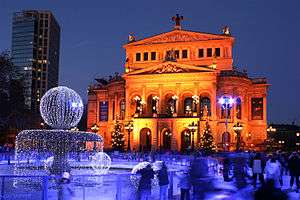
The Alte Oper is a former opera house, hence the name "Old Opera". It was built in 1880 by architect Richard Lucae. It was one of the major opera houses in Germany until it was heavily damaged in World War II. Until the late 1970s, it was a ruin, nicknamed "Germany's Most Beautiful Ruin". Former Frankfurt Lord Mayor Rudi Arndt called for blowing it up in the 1960s, which earned him the nickname "Dynamite-Rudi". (Later on, Arndt said he never had meant his suggestion seriously.)
Public pressure led to its refurbishment and reopening in 1981. Today, it functions as a famous concert hall, while operas are performed at the "new" Frankfurt Opera. The inscription on the frieze of the Alte Oper says: "Dem Wahren, Schönen, Guten" ("To the true, the beautiful, the good").
The Eschenheim Tower (Eschenheimer Turm) was erected at the beginning of the 15th century and served as a city gate as part of late-medieval fortifications. It is the oldest and most unaltered building in the Innenstadt district.
St. Catherine's Church (Katharinenkirche) is the largest evangelical church, dedicated to the martyred early Christian saint, Catherine of Alexandria. It is located in the city centre at the entrance to the Zeil, the central shopping street.
Although today "Hauptwache" is mostly associated with the inner-city underground train station of the same name, the name originates from a baroque building on the square above the station. The Hauptwache building was constructed in 1730 and was used as a prison, therefore the name that translates as "main guard-house". Today the square surrounding the building is also called "Hauptwache" (formal: An der Hauptwache). It is situated in the city centre opposite to St. Catherine's Church and houses a famous café.
Frankfurt Central Station (Frankfurt Hauptbahnhof), which opened in 1888, was built as the central train station for Frankfurt to replace three smaller train stations in the city centre and to boost the needed capacity for travellers. It was constructed as a terminus station and was the largest train station in Europe by floor area until 1915 when Leipzig Central Station was opened. Its three main halls were constructed in a neorenaissance-style, while the later enlargement with two outer halls in 1924 was constructed in neoclassic-style.
- Frankfurter Hof
The Frankfurter Hof is a landmarked hotel in the city centre at Kaiserplatz, built from 1872 to 1876. It is part of Steigenberger Hotels group and is considered the city's most prestigious.
20th-century architecture

- Frauenfriedenskirche and Holy Cross Church (with the Centre for Christian Meditation and Spirituality of the Diocese of Limburg), both consecrated 1929, are examples of early modernist church buildings during the time of the New Frankfurt.
- Grossmarkthalle, built 1926–1928 as a part of the New Frankfurt-project, the former wholesale market hall, was (following reconstruction) to become part of the future seat of the European Central Bank.
- Goethe House, rebuilt 1947. The birthplace of Johann Wolfgang von Goethe from 1749 was destroyed in World War II and then rebuilt true to the original.
- Junior-Haus, built 1951, an example of early post-World War II architecture located at Kaiserplatz.
- Bayer-Haus, built 1952, another example of early post-World War II architecture.
- Museum für angewandte Kunst, built 1985, designed by Richard Meier.
- IG Farben Building - Also known as Poelzig Building (Poelzig-Bau) after its architect Hans Poelzig, it was built from 1928 to 1930 as the corporate headquarters of I.G. Farbenindustrie AG. It is located in the Westend district and borders Grüneburgpark in the west. Upon its completion, the complex was the largest office building in Europe and remained so until the 1950s. The building served as headquarters for research projects relating to the development of synthetic oil and rubber and the manufacturing of magnesium, lubricating oil, explosives, methanol, and Zyklon B, the lethal gas used in concentration camps.[32][33] After World War II, it served as the headquarters for the Supreme Allied Command and from 1949 to 1952 the High Commissioner for Germany (HICOG). It became the principal location for implementing the Marshall Plan, which largely financed the post-war reconstruction of Europe. The state apparatus of the Federal German Government was devised there. It served as the headquarters for the US Army's V Corps and the Northern Area Command (NACOM) until 1995 when the US Army returned control of the IG Farben Building to the German government. It was purchased on behalf of the Goethe University Frankfurt by the state of Hesse. In October 2001 it became part of the Westend Campus of Goethe University.

21st-century architecture

- Die Welle (The Wave), built 1998–2003, a complex of three wavelike-formed office buildings next to the Opernplatz.
- Alte Stadtbibliothek, rebuilt 2003–2005, reconstruction of the old public library house originally built 1820–1825.
- Palais Thurn und Taxis, rebuilt 2004–2009, reconstruction of a palace originally built 1731–1739.
- MyZeil, built 2004–2009, shopping mall at the Zeil with an imposing vaulted glass-structure.
- The Squaire (portmanteau of square and air), also known as Airrail Center Frankfurt, is a 660 m (2,165.35 ft) long and 45 m (147.64 ft) tall office building located at Frankfurt Airport. It was built from 2006 to 2011 on top of an existing railway station (Frankfurt Airport long distance Station) and has a connecting bridge to Terminal 1 for pedestrians. Its total of 140,000 m2 (1,506,947 sq ft) rentable floor space makes it Germany's largest office building.
Skyscrapers

Frankfurt is one of the few European cities with a significant number of skyscrapers, (buildings at least 150 m (492.13 ft) tall). It hosts 14 out of Germany's 15 skyscrapers. Most skyscrapers and high-rise office buildings are located in the financial district (Bankenviertel) near the city centre, around the trade fair premises (Europaviertel) and at Mainzer Landstraße between Opernplatz and Platz der Republik, which connects the two areas.
The 14 skyscrapers are:
- Commerzbank Tower, 259.0 m (849.74 ft) — Europe's second tallest building, Headquarters of Commerzbank.
- Messeturm, 256.5 m (841.54 ft) — Europe's tallest building (1990–1997), Main tenant is Goldman Sachs (Germany).
- Westend Tower, 208.0 m (682.41 ft) — DZ Bank headquarters
- Main Tower, 200.0 m (656.17 ft) — Landesbank Hessen-Thüringen and Standard & Poor's (Germany) headquarters
- Tower 185, 200.0 m (656.17 ft) — PricewaterhouseCoopers (Germany) headquarters
- Trianon, 186.0 m (610.24 ft) — DekaBank headquarters
- Seat of the European Central Bank, 185.0 m (606.96 ft) — European Central Bank headquarters
- Opernturm, 170.0 m (557.74 ft) — UBS (Germany) headquarters
- Taunusturm, 170.0 m (557.74 ft)
- Silberturm, 166.3 m (545.60 ft) — Germany's tallest building (1978–1990), Main tenant is Deutsche Bahn.
- Westend Gate, 159.3 m (522.64 ft) — Germany's tallest building (1976–1978), Main tenant is Marriott Frankfurt Hotel.
- Deutsche Bank I, 155.0 m (508.53 ft) — Deutsche Bank headquarters
- Deutsche Bank II, 155.0 m (508.53 ft) — "
- Skyper, 153.8 m (504.59 ft) — Main tenant is DekaBank.
Other high-rise buildings include:
- Eurotower, 148.0 m (485.56 ft) — European Central Bank headquarters
- Frankfurter Büro Center, 142.4 m (467.19 ft) — Main tenant is Clifford Chance (Germany).
- City-Haus, 142.1 m (466.21 ft) — Main tenant is DZ Bank.
- Gallileo, 136.0 m (446.19 ft) — Main tenant is Commerzbank.

History of high-rise buildings
.jpg)
For centuries, St. Bartholomeus's Cathedral was the tallest structure. The first building to exceed the 95-metre-high cathedral was not an office building but a grain silo, the 120-metre high Henninger Turm, built from 1959 to 1961.
The first high-rise building boom came in the 1970s when Westend Gate (then called Plaza Büro Center) and Silberturm were constructed and became the tallest buildings in Germany with a height of 159.3 metres and 166.3 metres, respectively. Around the same time, Frankfurter Büro Center and City-Haus (142.4 metres and 142.1 metres) were constructed at Mainzer Landstraße and Eurotower (148.0 metres) and Garden Tower (127.0 metres; then called Helaba-Hochhaus) were constructed in the financial district.
None of the buildings constructed during the 1980s surpassed Silberturm. The most famous buildings from this decade are the Deutsche Bank Twin Towers at Taunusanlage, both 155.0 metres tall.
The 1990s featured a second wave. Messeturm, built on the trade fair site, reached a height of 256.5 metres and became the tallest building in Europe by 1991. It was overtaken by the 259-metre high Commerzbank Tower in 1997. Other tall buildings from this decade are Westendstrasse 1 (208.0 metres), Main Tower (200.0 metres) and Trianon (186.0 metres).
In 21st-century Frankfurt, more high-rise buildings and skyscrapers (e.g., Skyper, Opernturm, Tower 185, Seat of the European Central Bank, Taunusturm) emerged, but none have surpassed Commerzbank Tower.
Other tall structures

- Europaturm — The Europe Tower is a telecommunications tower, also known as the Frankfurt TV Tower, built from 1974 to 1979. With a height of 337.5 metres it is the tallest tower and the second tallest structure in Germany after the Fernsehturm Berlin. It was open to the public until 1999, with an entertainment establishment in the revolving top. It is normally referred to by locals as the "Ginnheimer Spargel" (Ginnheim Asparagus), but stands a few metres within Bockenheim district.
- Henninger Turm — The Henninger Tower was a 120-metre-high grain silo built from 1959 to 1961 and owned by Henninger Brewery. It was the highest structure until 1974. The Henninger Tower had two rotating restaurants at the height of 101 and 106 metres and an open-air observation deck at the height of 110 metres. The tower closed to the public in October 2002 and was demolished in 2013 to be replaced by a 140 m (459 ft) tall residential tower, which is externally inspired by the old Henninger Turm, and will contain 130 luxury apartments. The cornerstone for this project was laid in June 2014 and was expected to be completed sometime in 2016. From 1962 to 2008 a famous yearly cycling race was named after the tower, the "Radrennen Rund um den Henninger Turm" (Cycling race around Henninger Tower). The now-renamed race is still a yearly event.
- Goetheturm — The Goethe Tower is a 43-metre high tower on the northern edge of the Frankfurt City Forest in Sachsenhausen. It is the fifth tallest wood construction structure in Germany. It was built in 1931 and is still a popular place for day-trippers, especially families, who frequent a large playground and café at the foot of the tower. Climbing the Goethe Tower is free of charge and offers a spectacular view of the Frankfurt skyline.
Shopping streets
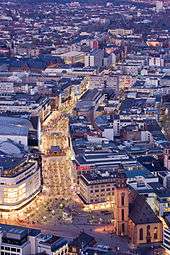
- Zeil — Frankfurt's central shopping street. It is a pedestrian-only area and is bordered by two large public squares, Hauptwache in the west and Konstablerwache in the east. It is the second most expensive street for shops to rent in Germany after the Kaufingerstraße in Munich. 85 percent of the shops are retail chains such as H&M, Saturn, Esprit, Zara or NewYorker. In 2009 a new shopping mall named MyZeil opened there with nearly 100 stores and chains like Hollister. Three more shopping malls occupy the Zeil: Zeilgalerie, Galeria Kaufhof and Karstadt, as well as large fashion retail clothing stores from Peek & Cloppenburg and C&A. During the month before Christmas, the extended pedestrian-only zone is host to Frankfurt Christmas Market, one of the largest and oldest Christmas markets in Germany.
- Goethestraße — Frankfurt's most expensive shopping street with prestigious shops like Louis Vuitton, Prada, Gucci, Tiffany, Giorgio Armani, Versace, Cartier, Burberry, Vertu and Bulgari. It is located between the financial district and the city centre and runs from Goetheplatz to Opernplatz.
- Freßgass — (officially Kalbächer Gasse and Große Bockenheimer Straße) is a pedestrian-only street section between Börsenstraße and Opernplatz in the city centre. The name translates as "feeding alley" because of its high concentration of gastronomy, but lately prestigious shops (e.g., Apple Store, Hugo Boss, Porsche Design) have moved here due to the lack of space in the neighbouring Goethestraße, displacing old, established restaurants, butchers and delicatessens.
- Berger Straße — Frankfurt's longest shopping street. It starts in the city center, runs through Nordend and Bornheim and ends in Seckbach. The street is less crowded than the Zeil and offers a greater variety of smaller shops, restaurants and cafés.
- Braubachstraße — in the Altstadt district, close to the historic sites of the city, offers a large variety of art galleries, second-hand bookshops and antique shops.
- Münchener Straße — In the Bahnhofsviertel district, located between the central station and Willy-Brandt-Platz, is the most multicultural shopping street with lots of shops that sell imported products mainly from Turkey, the Middle East and Asia.
- Kaiserstraße — One of the best-known streets and considered one of the most beautiful because of its amount of Gründerzeit-style buildings. It runs parallel to Münchener Straße from the central station to the financial district. Kaiserstraße is still a synonym for Frankfurt's Red-light district although sex-oriented businesses moved to neighbouring streets such as Taunusstraße in the 1990s. Today Kaiserstraße houses many smaller shops, restaurants and cafés.
- Kleinmarkthalle — (literally: Small Market Hall) is a market hall in the city centre close to Konstablerwache offering fresh food and flowers. In addition to regional delicacies like green sauce imported goods are offered. The Kleinmarkthalle is the largest public market place in Frankfurt.
Green city
With a large forest, many parks, the Main riverbanks and the two botanical gardens, Frankfurt is considered a "green city": More than 50 percent of the area within the city limits are protected green areas.[34]


- Frankfurter Grüngürtel — The Green Belt is a ring-shaped public green space around the city. With 8,000 ha it covers a third of the administrative area. It includes the Frankfurter Stadtwald (Frankfurt City Forest, Germany's largest forest within a city), the Schwanheimer Düne (Schwanheim Dune), the Niddatal (Nidda Valley), the Niddapark, the Lohrberg (Lohr Mountain, Frankfurt's only vineyard), the Huthpark, the Enkheimer Ried (Enkheim Marsh), the Seckbacher Ried (Seckbach Marsh) and the Fechenheimer Mainbogen (a S-shaped part of the Main river in Fechenheim). The Green Belt is a protected area which means that housing is not allowed. The Green Belt was formally created in 1991 with its own constitution.
- Mainuferpark — The Mainuferpark (Main Riverbanks Park) is the common term to describe the inner-city Main riverbanks. It is an auto-free zone with large green areas that is popular with strollers and tourists, especially in the summertime, when it can become crowded. The southern riverbank, which continues further to Offenbach am Main and Hanau, offers the best skyline views. The northern riverbank ends in the west at the former Westhafen (West Harbour, a residential housing area) and is growing to the east: A former industrial-used area between the future Seat of the European Central Bank and the Osthafen (East Harbour) was to become a park named Hafenpark (Harbour Park).
- Wallanlagen — The Wallanlagen (analogous: Ramparts) relate to the former ring-shaped city wall fortifications around the Altstadt and the Innenstadt district (abolished 1804–1812), now a series of parks. Building is not allowed, with a few exceptions, the most famous being the Alte Oper (built 1880) at the Opernplatz. The part between the northern Main riverbank and the Opernplatz, referred to officially as Taunusanlage and Gallusanlage, is locally known as "Central Park" (a reference to the famous park in Manhattan), because of the skyscrapers which stand on both sides.
- Nizza Park — At the juncture of the northern Main riverbank and the Wallanlagen is a famous small park called Nizza. The name of the park recalls Nice in southern France, because it is one of the warmest areas with a nearly mediterranean climate. Numerous Mediterranean flora grow there and can survive outside during the winter.
- Garten des Himmlischen Friedens — Garden of Heavenly Peace, named after the Tiananmen Gate in Beijing, is a Chinese-styled park in the Nordend district and part of the larger Bethmannpark. It contains Chinese buildings, with building materials imported from China and built by Chinese workers in the 1980s. Hosts traditional Chinese plants and herbs.
- Other parks — The largest parks are the Niddapark (168 ha), the Ostpark (32 ha) and the Grüneburgpark (29 ha).
Culture
Museums


With more than 30 museums, Frankfurt has one of the largest variety of museums in Europe. 20 museums are part of the Museumsufer (Museums Riverbank), located on the front row of both sides of the Main riverbank or nearby.
Ten museums are located on the southern riverbank in Sachsenhausen between the Eiserner Steg and the Friedensbrücke. The street itself, Schaumainkai, is partially closed to traffic on Saturdays for Frankfurt's largest flea market.
- Deutsches Architekturmuseum (German Architecture Museum)
- Deutsches Filmmuseum (German Film Museum)
- Frankfurter Ikonenmuseum (Icon Museum Frankfurt)
- Liebieghaus (Museum of Municipal Sculptures)
- Museum für Angewandte Kunst (Museum of Applied Arts)
- Museum Giersch (Museum for Regional Art)
- Museum für Kommunikation (Museum of Communications)
- Museum der Weltkulturen (Museum of World Cultures)
- Städel, one of the most famous art museums in Germany
- Bibelhaus Erlebnis Museum (Bible House Experience Museum)
Two museums are located on the northern riverbank:
- Jüdisches Museum Frankfurt (Jewish Museum Frankfurt)
- Historisches Museum Frankfurt (Historical Museum Frankfurt)
Not directly located on the northern riverbank in the Altstadt district are:
- Museum für Moderne Kunst (Museum of Modern Art)
- Schirn Kunsthalle Frankfurt (Schirn Art Gallery Frankfurt)
- Frankfurter Kunstverein (Art Association Frankfurt)
- Museum Judengasse (Jews' Alley Museum)
- Goethe-Haus (Goethe House)
- Archäologisches Museum Frankfurt (Archaeological Museum Frankfurt)
- Caricatura Museum für Komische Kunst (Caricatura Museum of Comical Art)
- Dommuseum Frankfurt (Frankfurt Cathedral Museum)
Another important museum is located in the Westend district:
- Naturmuseum Senckenberg (Senckenberg Natural History Museum), the second largest natural history museum in Germany
Other museums are the Dialogmuseum (Dialogue Museum) in the Ostend district, Eintracht Frankfurt Museum at Commerzbank-Arena, Explora Museum+Wissenschaft+Technik (Explora Museum of Science and Engineering) in the Nordend district, the Frankfurter Feldbahnmuseum e.V. (Light Railway Museum Frankfurt) in the Gallus district, the Verkehrsmuseum Frankfurt (Transport Museum Frankfurt) in the Schwanheim district, the Hammer Museum in the Bahnhofsviertel district and the Geldmuseum der Deutschen Bundesbank (Money Museum of the German Federal Bank) in the Ginnheim district.
Performing arts

Eurodance and Trance music originated in Frankfurt. In 1989 German producers Michael Münzing and Luca Anzilotti (under the pseudonyms Benito Benites and John "Virgo" Garrett III) formed the Snap! project. Snap! songs combined Rap and Soul vocals adding rhythm by using computer technology and mixing electronic sounds, bass and drums. By doing so a new genre was born: Eurodance.[35] In the early 1990s, DJs including Sven Väth and DJ DAG (of Dance 2 Trance) first played a harder, deeper style of acid house that became popular worldwide over the next decade as Trance music. Some of the early and most influential Eurodance, Trance and Techno acts, e.g., La Bouche, Jam and Spoon, Magic Affair, Culture Beat, Snap!, Dance 2 Trance, Oliver Lieb and Hardfloor, and record labels such as Harthouse and Eye Q, were based in the city in the early 1990s.
- Oper Frankfurt — A leading Germany opera company and one of Europe's most important. It was elected Opera house of the year (of Germany, Austria and German-speaking Switzerland) by German magazine Opernwelt in 1995, 1996 and 2003. It was also elected Best opera house in Germany in 2010 and 2011. Its orchestra was voted Orchestra of the year in 2009, 2010 and 2011.[36]
- Schauspiel Frankfurt — Theatre at Willy-Brandt-Platz in the financial district, next to the Frankfurt Opera.
- Frankfurt Radio Symphony (hr-Sinfonieorchester in German) - one of the top symphony orchestras in the world
- Festhalle Frankfurt — Multi-purpose hall next to the Messeturm at the grounds of the Frankfurt Trade Fair. It is mostly used for concerts, exhibitions or sport events and can accommodate up to 13,500.
- Commerzbank-Arena — Frankfurt's largest sports stadium and one of Germany's ten largest. It is located in the Frankfurt City Forest near Niederrad. It is primarily used for soccer and concerts with a capacity up to 51,500. It opened in 1925 and underwent several major reconstructions. Locals still prefer to call the stadium by its traditional name, Waldstadion (Forest Stadium).
- Alte Oper — A major concert hall.
- Jahrhunderthalle — Century Hall is a large concert and exhibition hall in Unterliederbach district. Sometimes referred to as "Jahrhunderthalle Höchst", because it was built to celebrate the 100th anniversary of the chemical company Hoechst AG in 1963.
- The English Theatre — Located on the ground floor of the Gallileo high-rise building, this is the largest anglophone theatre in continental Europe. It was established in 1979.
- Tigerpalast — Tiger Palace is a varieté in the city centre near the Zeil. It was established in 1988 and houses the famous Tiger-Restaurant which was awarded a Michelin star.
- Künstlerhaus Mousonturm — House of Artists Mouson Tower is a free theatre, which means that it has a smaller budget than traditional theatres and used more unconventional performing methods. It is located in an old factory in the Ostend district.
- Die Schmiere — The Grease is a cabaret and Frankfurt's oldest privately owned theatre. It is located in the Karmeliterkloster in the Altstadt district. According to its own advertising it is the worst theatre in the world.
- Die Komödie — The Comedy is a boulevard theatre in the city centre near Willy-Brandt-Platz.
Botanical gardens

Frankfurt is home to two major botanical gardens.
- Palmengarten — Located in the Westend district, it is Hesse's largest botanical garden covering 22 ha. It opened to the public in 1871. The botanical exhibits are organized according to their origin in free-air or in greenhouses that host tropical and subtropical plants, hence the name "Palm Garden".
- Botanischer Garten der Goethe-Universität — The university's botanical garden is also an arboretum. It contains about 5,000 species, with special collections of Rubus (45 species) and indigenous plants of central Europe. It is organized into two major areas: The geobotanical area contains an alpine garden, arboretum, meadows, steppes, marsh, and a pond, as well as collections of plants from the Canary Islands, Caucasus, East Asia, Mediterranean, and North America and the systematic and ecological collection includes crop plants, endangered species, ornamental plants, roses, and the Neuer Senckenbergischer Arzneipflanzengarten (New Senckenberg Medicinal Plant Garden, 1200 m²). The Botanical Garden, the neighbouring Palmengarten and the neighbouring Grüneburgpark form the largest inner-city green area.
Foreign culture

- Instituto Cervantes — Named after Miguel de Cervantes, one of the most important Spanish authors, this is the world's largest organization for promoting the study and teaching of Spanish language and culture. 54 such Centros Cervantes across the world offer Spanish language and history courses. The Frankfurt branch was officially opened in September 2008 by Felipe, Prince of Asturias and his wife Letizia, Princess of Asturias. It is located in the so-called Amerika-Haus.
- Central and Eastern European Online Library — CEEOL is an online archive providing access to full text articles from humanities and social science scholarly journals on Central, Eastern and South Eastern European topics. Subject areas include anthropology, culture and society, economy, gender studies, history, Judaic studies, fine arts, literature, linguistics, political sciences and social sciences, philosophy and religion. CEEOL is operated by Questa.Soft GmbH.
Festivals
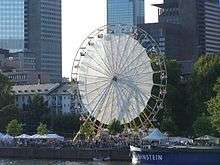


- Museumsuferfest — Museums Riverbank Festival is one of Germany's biggest cultural festivals, attracting more than 3 million visitors over three days at the end of August along the Main riverbank in the city centre. The 20 museums there open far into the night. It offers live music, dance shows, booths for crafts, jewellery, clothes and food stands from around the world.
- Dippemess — Frankfurt's oldest folk festival is the Festival of Stoneware, which takes place semi-annually around Easter and the end of September in the eastern area. "Dippe" is a regional Hessian dialect word meaning "pot" or "jar" which would not be understood in most other German regions. Mentioned for the first time in the 14th century as an annual marketplace it is now more of an amusement park. The name of the festival derives from its original purpose, when it was a fair where traditionally crafted jars, pots and other stoneware were on offer.
- Wäldchestag — Day of the forest is known as a regional holiday because until the 1990s it was common that Frankfurt's shops were closed on this day. The festival takes place over four days after Pentecost with the formal Wäldchestag on Tuesday. Its unique location is in the Frankfurt City Forest, south-west of the city centre in Niederrad. "Wäldches" is a regional dialect of the German word "Wäldchen", meaning "small forest".
- Nacht der Museen — Night of the museums takes place every year in April or May. 50 museums in Frankfurt and in the neighbouring city of Offenbach am Main are open until 2:00 AM surrounded by special music events, dance performances, readings and guided tours. A free shuttle operates between the museums. In 2010, approximately 40,000 visitors attended.
- Nacht der Clubs — Night of the clubs is an event similar to Nacht der Museen: On one night as many as 20 clubs can be visited with a single ticket for €12. Usually club-door-policies are loosened to attract new customers. A free shuttle runs between the clubs. 15,000 people participated in 2008.
- Luminale — The "festival of light" takes place biannually since 2000, parallel to the Light + building exhibition at the trade fair. Many buildings are specially lit for the event. In 2008, more than 220 light installations could be seen and attracted 100,000 visitors. The last Luminale was held in April 2012.
- Wolkenkratzer Festival — The Skyscraper Festival is unique in Germany. It takes place irregularly, lately in May 2013, and attracted around 1.2 million visitors. For two days most skyscrapers are open to the public. Sky-divers, base jumpers, fireworks and laser shows are extra attractions.
Nightlife
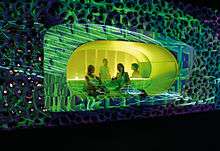

Frankfurt offers a variety of restaurants, bars, pubs and clubs. Clubs concentrate in and around the city centre and in the Ostend district, mainly close to Hanauer Landstraße. Restaurants, bars and pubs concentrate in Sachsenhausen, Nordend, Bornheim and Bockenheim.
One of the main venues of the early Trance music sound was the Omen nightclub (closed 1998). Another popular disco club of the 1980-1990s and a hotspot for Techno/Trance music was the Dorian Gray, located within Terminal 1 at Frankfurt Airport. Because of the location at the airport the club had no restrictions regarding opening hours. The club had to close at the end of 2000 because of stricter fire safety regulations. Also notable for its extraordinary design was Coocoon Club in Fechenheim which opened in 2004 was and voted best techno club of the year by music magazines "Groove" and "Raveline" in 2004, 2005, 2006 and 2007. It closed in 2012.[37]
- King Kamehameha Club — named after the first king of Hawaii and a fictional Club in Magnum, P.I., was a disco club at Hanauer Landstraße, known for live music. It opened in 1999 and expanded with a beach club in Offenbach am Main and a restaurant (King Kamehameha Suite) in the financial district.
- U60311 — Techno club in the city centre. "60311" is the postal code of the area. It was voted best club of the year by music magazines "Groove" and "Raveline" multiple times. Its location was an underground former pedestrian underpass. It closed in 2012.
- Living XXL — Club/restaurant in the financial district, it was located on the ground floor of the Eurotower and closed in 2013. [38]
- Club 101 — Located on the 24th floor of the Japan Center. It will be closing at the end of 2016. [39]

- Batschkapp — Alternative rock club, located in Frankfurt-Seckbach. It opened in 1976 and attracts mostly people with a left-wing political attitude. Joschka Fischer, Germany's former Foreign Minister, was a regular guest in the 1980s.
- Velvet Club (Innenstadt)
- Cooky's (Innenstadt)
- Nachtleben (Innenstadt)
- Silbergold (Innenstadt)
- Sinkkasten Arts Club (Innenstadt) — Closed in 2012, replaced by Zoom club.
- Tanzhaus West (Gutleutviertel)
- Dora Brillant (Gutleutviertel)
- Odeon (Nordend)
- Monza (Innenstadt) — Closed in 2013. [40]
- Travolta (Innenstadt)
Domestic culture
- Frankfurt kitchen — Designed originally in 1926 for the New Frankfurt-project and built in some 10,000 units, the kitchen became a milestone in domestic architecture, considered the forerunner of modern fitted kitchens.
- Frankfurt cupboard — The Baroque Frankfurt-style cupboards were used to store the family linen, one of them by Goethe's father, who took one cupboard to Rome. The most luxurius versions have wave-shaped parts, some are made of solid cherry wood inlaid with plumwood.
Culinary specialties
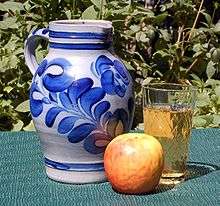
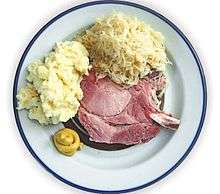
- Apfelwein — Apple wine or hard cider is regionally known as "Ebbelwoi", "Äppler" or "Stöffsche". It has an alcohol content of 5.5%–7% and a tart, sour taste. It is traditionally served in a glass, typically decorated with lozenges, called "Geripptes", a full glass is then called "Schoppen". Apfelwein is also available in a stoneware jar locally known as "Bembel". A group normally orders a "Bembel" and shares the content. Apfelwein can be ordered as "sauergespritzer", which is apfelwein blended with 30% mineral water or as "süssgespritzer", which is Apfelwein blended with lemon soda, orange soda or fresh-pressed apple juice (lemon soda being the most common). Most of the pubs which serve Apfelwein are located in Sachsenhausen, which is therefore known as "Ebbelwoi district". Due to its national drink Frankfurt is sometimes called "Big Ebbel" (pronunciation with hessian dialect), an homage to Big Apple, the famous nickname of New York City.
- Grüne Soße — Green sauce is a sauce made with hard-boiled eggs, oil, vinegar, salt and generous amount of seven fresh herbs, namely borage, sorrel, garden cress, chervil, chives, parsley and salad burnet. Variants, often due to seasonal availability include dill, lovage, lemon balm and spinach. Original green sauce Frankfurt-style is made of herbs that were gathered only on fields within the city limits.
- Frankfurter Würstchen — "short Frankfurter" is a small sausage made of smoked pork smoked. They are similar to Hot dogs. The name Frankfurter Würstchen has been trademarked since 1860.
- Frankfurter Rindswurst — Sausage made of pure beef.
- Frankfurter Rippchen — Also known as Rippchen mit Kraut, this is a traditional dish which consists of cured pork cutlets, slowly heated in sauerkraut or meat broth, and usually served with sauerkraut, mashed potatoes and yellow mustard.
- Handkäs mit Musik — German regional sour milk cheese (similar to Harzer) and a culinary specialty in the Rhine Main Region. The traditional way producing it is by hand. When it is topped with chopped onions it becomes "Handkäs mit Musik" (with music) because the onions are supposed to stimulate flatulence.
- Frankfurter Kranz — Cake speciality believed to originate from Frankfurt.
- Bethmännchen — "A little Bethmann" is a pastry made from marzipan with almond, powdered sugar, rosewater, flour, and egg. It is usually baked for Christmas.
Transport
Airports

Frankfurt Airport
The city can be accessed from around the world via Frankfurt Airport (Flughafen Frankfurt am Main) located 12 km (7 mi) southwest of the city centre. The airport has four runways and serves 265 non-stop destinations. Run by transport company Fraport it ranks among the world's busiest airports by passenger traffic and is the second-busiest airport by cargo traffic in Europe. The airport also serves as a hub for Condor and as the main hub for German flag carrier Lufthansa. Depending upon whether total passengers or flights are used for calculations, it ranks third or second busiest in Europe alongside London Heathrow Airport and Paris Charles de Gaulle Airport. Passenger traffic at Frankfurt Airport in 2012 was 57.5 million. There are plans to expand the airport with a third passenger terminal to increase the capacity up to 88 million in 2020.
The airport can be reached by car or bus and has two railway stations, one for regional and one for long-distance traffic. The S-Bahn lines S8 and S9 (direction Offenbach Ost or Hanau Hbf) departing at the regional station take 10–15 minutes from the airport to Frankfurt Central Station and onwards to the city centre (Hauptwache station), the IC and ICE trains departing at the long-distance station take 10 minutes to Frankfurt Central Station.
Frankfurt Hahn Airport
Despite the name, Frankfurt Hahn Airport (Flughafen Frankfurt-Hahn) is situated approximately 120 km (75 mi) from the city in Lautzenhausen (Rhineland-Palatinate). Hahn Airport is a major base for low-cost carrier Ryanair. This airport can only be reached by car or bus. An hourly bus service runs from Frankfurt Central Station, taking about 1-hour and 45 minutes. Passenger traffic at Hahn Airport in 2010 was 3.5 million.
Frankfurt Egelsbach Airport
Frankfurt Egelsbach Airport (Flugplatz Frankfurt-Egelsbach) is a busy general aviation airport located south-east of Frankfurt Airport, near Egelsbach.
Roads
Frankfurt is a traffic hub for the German motorway (Autobahn) system. The Frankfurter Kreuz is an Autobahn interchange close to the airport, where the Bundesautobahn 3 (A3), Cologne to Würzburg, and the Bundesautobahn 5 (A5), Basel to Hannover, meet. With approximately 320,000 cars passing through it every day it is Europe's most heavily used interchange. The Bundesautobahn 66 (A66) connects Frankfurt with Wiesbaden in the west and Fulda in the east. The Bundesautobahn 661 (A661) is mainly a commuter motorway which starts in the south (Egelsbach), runs through the eastern part and ends in the north (Oberursel). The Bundesautobahn 648 (A648) is a very short motorway in the western part which primarily serves as a fast connection between the A 66 and the Frankfurt Trade Fair. The A5 in the west, the A3 in the south and the A661 in the north-east form a ring road around the inner city districts and define a Low-emission zone (Umweltzone; established in 2008), meaning that vehicles have to meet certain emission criteria to enter the zone.
The streets of central Frankfurt are usually congested with cars during rush hour. Some areas, especially around the shopping streets Zeil, Goethestraße and Freßgass, are pedestrian-only streets. Car parks are located throughout the city and especially in the city centre.
Railway stations
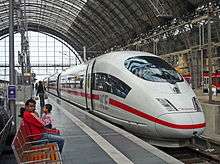
Frankfurt Central Station
Frankfurt Central Station (Frankfurt Hauptbahnhof, often abbreviated as Frankfurt (Main) Hbf or F-Hbf) is the largest railway station in Germany by railway traffic. By daily passenger volume, it ranks second together with Munich Central Station (350,000 each) after Hamburg Central Station (450,000). It is located between the Gallus, the Gutleutviertel and the Bahnhofsviertel district, not far away from the trade fair and the financial district. It serves as a major hub for long-distance trains (InterCity, ICE) and regional trains as well as for Frankfurt's public transport system. It is a stop for most of ICE high speed lines, making it Germany's most important ICE station. ICE Trains to London via the Channel Tunnel were planned for 2013.[41] All Rhine-Main S-Bahn lines, two U-Bahn lines (U4, U5), several tram and bus lines stop there. Regional and local trains are integrated in the Public transport system Rhein-Main-Verkehrsverbund (RMV), the second largest integrated public transport systems in the world, after Verkehrsverbund Berlin-Brandenburg.
Frankfurt Airport stations
Frankfurt Airport can be accessed by two railway stations: Frankfurt Airport long-distance station (Frankfurt Flughafen Fernbahnhof) is only for long-distance traffic and connects the airport to the main rail network, with most of the ICE services using the Cologne-Frankfurt high-speed rail line. The long-distance station is located outside the actual airport ground but has a connecting bridge for pedestrians to Terminal 1, concourse B. Frankfurt Airport regional station (Frankfurt Flughafen Regionalbahnhof) is for local S-Bahn trains (lines S8, S9) and regional trains. The regional station is located within Terminal 1, concourse B.
Frankfurt South station
Frankfurt's third long-distance station is Frankfurt South station (Frankfurt Südbahnhof, often abbreviated as Frankfurt (Main) Süd or F-Süd), located in Sachsenhausen. It is an important destination for local trains and trams (lines 14 to 16, 19) and the terminal stop for four U-Bahn lines (U1, U2, U3, U8) and two S-Bahn lines (S5, S6).
Messe stations
The Frankfurt Trade Fair offers two railway stations: Messe station is for local S-Bahn trains (lines S3-S6) and is located at the centre of the trade fair premises while Festhalle/Messe station is served by U-Bahn line U4 and is located at the north-east corner of the premises.
Konstablerwache station and Hauptwache station
Two other major railway stations in the city centre are Konstablerwache and Hauptwache, located on each end of the Zeil. They are the main stations to change from east-to-west-bound S-Bahn trains to north-to-south-bound U-Bahn trains. Konstablerwache station is the second-busiest railway station regarding daily passenger volume (191,000) after the central station. The third-busiest railway station is Hauptwache station (181,000).
Public transport

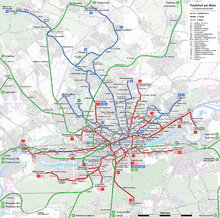
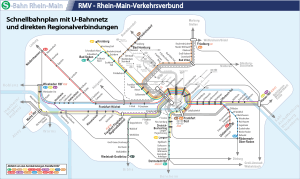
The city has two rapid transit systems: the U-Bahn and the S-Bahn, as well as an above-ground tram system. Information about the U- and S-Bahn can be found on the website of the RMV.[42]
S-Bahn
Nine S-Bahn lines (S1 to S9) connect Frankfurt with the densely populated Rhine Main Region. Most routes have at least 15-minute service during the day, either by one line running every 15 minutes, or by two lines servicing one route at a 30-minute interval. All lines, except line S7, run through the Frankfurt city tunnel and serve the stations Ostendstraße, Konstablerwache, Hauptwache, Taunusanlage and Frankfurt Central Station. When leaving the city the S-Bahn travels above ground. It provides access to the trade fair (S3, S4, S5, S6), the airport (S8, S9), the stadium (S7, S8, S9) and nearby cities such as Wiesbaden, Mainz, Darmstadt, Rüsselsheim, Hanau, Offenbach am Main, Oberursel, Bad Homburg, Kronberg, Friedberg and smaller towns that are on the way.
U-Bahn
The U-Bahn has nine lines (U1 to U9) serving Frankfurt and the larger suburbs of Bad Homburg and Oberursel in the north. The trains that run on the line are in fact lightrails as many lines travel along a track in the middle of the street instead of underground further from the city centre. The minimum service interval is 2.5 minutes, although the usual pattern is that each line runs at 7.5 to 10 minute intervals, which produce between 3 and 5 minute intervals on city centre tracks shared by more than one line.
Tram
Frankfurt has ten tram lines (11, 12, 14 to 21), with trams arriving usually every 10 minutes. Many sections are served by two lines, combining to run at 5-minute intervals during rush-hour. The tram runs only above ground and serve more stops than the U-Bahn or the S-Bahn.
Bus
A number of bus lines complete the Frankfurt public transport system. Night buses replace U-Bahn and tram services between 1:30 am and 3:30 am.[43] The central junction for the night bus service is Konstablerwache in the city centre, where all night bus lines start and end.
Taxis
Taxis can usually be found outside the major S-Bahn and U-Bahn stations, at the central station, the south station, the airport, the trade fair and in the crowded inner-city shopping streets. The common way to obtain a taxi is to either call a taxi operator or to go to a taxi rank. However, although not the norm, one can hail a passing taxi on the street.
Uber ceased Frankfurt operations on November 9, 2015. It is unknown when services will resume.[44]
Bicycles

Deutsche Bahn makes bicycles available for hire through their Call a Bike service. The bicycles are stationed all over the city, including at selected railway stations. They can easily be spotted because of their eye-catching silver-red colour. To rent a specific bike, riders either call a service number to get an unlock code or reserve the bike via the smartphone application. To return the bike, the rider locks it within a designated return area (and calls the service number, if not booked via the app).[45]
Nextbike also makes bicycles available for hire in Frankfurt. They are stationed all over the city. These can be spotted with their blue color scheme.
Cycle rickshaws (velotaxis), a type of tricycle designed to carry passengers in addition to the driver, are also available. These are allowed to operate in pedestrian-only areas and are therefore practical for sightseeing.
Frankfurt has a network of cycle routes. Many long-distance bike routes into the city have cycle tracks that are separate from motor vehicle traffic. A number of roads in the city centre are "bicycle streets" where the cyclist has the right of way and where motorised vehicles are only allowed access if they do not disrupt the cycle users. In addition, cyclists are allowed to ride many cramped one-way streets in both directions. As of 2015, 15 percent of citizens used bicycles.[46]
Economy and business
Frankfurt is one of the world's most important financial centres and Germany's financial capital, followed by Munich. Frankfurt was ranked 8th at the International Financial Centers Development Index (2013), 8th at the Worldwide Centres of Commerce Index (2008), 9th at the Global Financial Centres Index (September 2013),[47] 10th at the Global Power City Index (2011), 11th at the Global City Competitiveness Index (2012), 12th at the Innovation Cities Index (2011),[48] 14th at the World City Survey (2011) and 23rd at the Global Cities Index (2012).[49]
The city's importance as a financial centre has risen since the eurozone crisis. Indications are the establishment of two institutions of the European System of Financial Supervisors (European Insurance and Occupational Pensions Authority and European Systemic Risk Board) in 2011 and the Single Supervisory Mechanism by which the European Central Bank was to assume responsibility for specific supervisory tasks related to the financial stability of the biggest and most important Eurozone banks.
According to an annual study by Cushman & Wakefield, the European Cities Monitor (2010), Frankfurt has been one of the top three cities for international companies in Europe, after London and Paris, since the survey started in 1990.[50] It is the only German city considered to be an alpha world city (category 3) as listed by the Loughborough University group's 2010 inventory,[51] which was a promotion from the group's 2008 inventory when it was ranked as an alpha minus world city (category 4).[52]
With over 922 jobs per 1,000 inhabitants, Frankfurt has the highest concentration of jobs in Germany. On work days and Saturdays one million people commute from all over the Rhein-Main-Area.
Central banks

Frankfurt is home to two important central banks.
European Central Bank
The European Central Bank (Europäische Zentralbank) is one of the world's most important central banks. The ECB sets monetary policy for the Eurozone, consisting of 19 European Union member states that have adopted the Euro (€) as their common currency. Since 1998 the ECB Headquarters are located in the Eurotower at Willy-Brandt-Platz and in two other nearby high-rises. The future Seat of the European Central Bank in the Ostend district, consisting of the former wholesale market hall (Großmarkthalle) and a newly built 185-metre skyscraper, were expected to be completed by early 2014. The new building complex was to accommodate up to 2,300 ECB personnel. The location is a few miles away from the city centre and borders an industrial area as well as the Osthafen (East Harbour), It was primarily chosen because of its large premises which allows the ECB to install security arrangements without high fences.
The city honours the importance of the ECB by officially using the slogan "The City of the Euro" since 1998.
German Federal Bank
The German Federal Bank (Deutsche Bundesbank), located in Ginnheim, was established in 1957 as the central bank for the Federal Republic of Germany. Until the euro (€) was introduced in 1999, the Deutsche Bundesbank was responsible for the monetary policy of Germany and for the German currency, the Deutsche Mark (DM). The Bundesbank was greatly respected for its control of inflation through the second half of the 20th century. Today the Bundesbank is an integral part of the European System of Central Banks (ESCB) which is formed by all 27 European Union member states.
Commercial banks
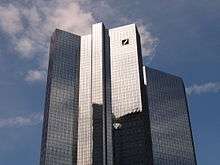
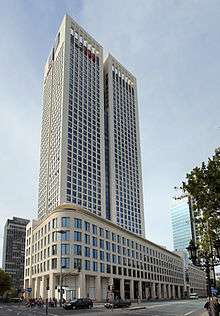
In 2010, 63 national and 152 international banks had a registered office, including the headquarters of the major German banks, as well as 41 offices of international banks.[6] Frankfurt is therefore known as Bankenstadt ("City of the banks") and nicknamed "Mainhattan" (a portmanteau of the local Main river and Manhattan in New York City) or "Bankfurt". 73,200 people were employed at banks in 2010.
- Deutsche Bank — Germany's largest commercial bank. It had 15% share of private customers and total assets of €1,900 billion in 2010. Deutsche Bank ranks among the 30 largest banks in the world and the ten largest banks in Europe.[53] Deutsche Bank is listed on the DAX, the stock market index of the 30 largest German business companies at the Frankfurt Stock Exchange. In November 2010 Deutsche Bank bought the majority of shares of competitor Postbank. Its headquarters are located at Taunusanlage in the financial district.
- Commerzbank — Germany's second-largest commercial, bank with total assets of €754 billion (2010). In 2009, Commerzbank merged with competitor Dresdner Bank, then the third-largest German bank. Due to the merger and the higher credit risks, Commerzbank was partially nationalized (25 percent) during the financial crisis in 2009. It is listed in the DAX. Its headquarters are at Commerzbank Tower (259 metres), the 2nd tallest building in the European Union, at Kaiserplatz.
- KfW Bankengruppe —Government-owned development bank formed in 1948 as part of the Marshall Plan. KfW provides loans for approved purposes at lower rates than commercial banks, especially to medium-sized businesses. With total assets of €442 billion (2010), it is Germany's third-largest bank. The KfW Headquarters are located in the Westend district at Bockenheimer Landstraße and Senckenberganlage.
- DZ Bank — Central institution for more than 900 co-operative banks (Volksbanken und Raiffeisenbanken) and their 12,000 branch offices in Germany and is a corporate and investment bank. It is Germany's fourth-largest bank (total assets: €383 billion). The DZ Bank Group defines itself primarily as a service provider for the local Volksbanken and Raiffeisenbanken and their 30 million clients. The DZ Bank headquarters are the Westend Tower and the City-Haus at Platz der Republik. The DZ Bank Group includes Union Investment, DVB Bank and Reisebank, which are also headquartered in Frankfurt.
- Landesbank Hessen-Thüringen — Landesbank Hessen-Thüringen, or short Helaba, is the central federal bank (Landesbank) for the federal states of Hesse and Thuringia. As such, it is state-owned and defined as a service provider for the local German public banks (Sparkassen). Helaba is one of nine Landesbanken and is the fifth-largest in Germany. It is located in the 200-metre-tall Main Tower in the financial district, the only skyscraper with an observation desk open to the public.
- DekaBank — DekaBank is the central asset manager of the Sparkassen in Germany. The headquarters of DekaBank are located at the Trianon skyscraper at Mainzer Landstraße.
- ING Diba Germany — Germany's largest direct bank, headquartered in Bockenheim.
Other major German banks include Frankfurter Volksbank, the second-largest Volksbank in Germany, Frankfurter Sparkasse and old-established private banks such as Bankhaus Metzler, Hauck & Aufhäuser and Delbrück Bethmann Maffei.
Many international banks have a registered or a representative office, e.g., Credit Suisse, UBS, Bank of America, Morgan Stanley, Goldman Sachs, Merrill Lynch, JPMorgan Chase & Co., Bank of China, Banco do Brasil, Itaú Unibanco Société Générale, BNP Paribas, SEB, Royal Bank of Scotland and Barclays.
Frankfurt Stock Exchange

The Frankfurt Stock Exchange (Frankfurter Wertpapierbörse) began in the 9th century. By the 16th century Frankfurt had developed into an important European hub for trade fairs and financial services. Today the Frankfurt Stock Exchange is by far the largest in Germany, with a turnover of more than 90 percent of the German stock market and is the third-largest in Europe after the London Stock Exchange and the European branch of the NYSE Euronext. The most important stock market index is the DAX, the index of the 30 largest German business companies listed at the stock exchange. The stock exchange is owned and operated by Deutsche Börse, which is itself listed in the DAX. Deutsche Börse also owns the European futures exchange Eurex and clearing company Clearstream. Trading takes place exclusively via the Xetra trading system, with redundant floor brokers taking on the role of market-makers on the new platform.
On 1 February 2012 European Commission blocked the proposed merger of Deutsche Börse and NYSE Euronext. "The merger between Deutsche Börse and NYSE Euronext would have led to a near-monopoly in European financial derivatives worldwide", European competition commissioner, Joaquín Almunia, said.
It is located in the city centre at the Börsenplatz. Deutsche Börse's headquarters are formally registered in Frankfurt but it moved most of its employees a high-rise called "The Cube" in Eschborn in 2010, primarily due to significantly lower local corporate taxes.
Frankfurt Trade Fair
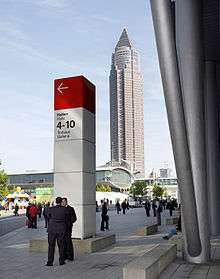
Frankfurt Trade Fair (Messe Frankfurt) has the third-largest exhibition site in the world with a total of 578,000 square metres (6,221,540 square feet). The trade fair premises are located in the western part between Bockenheim, the Westend and the Gallus district. It houses ten exhibition halls with a total of 321,754 square meters (3,463,331 square feet) of space and 96,078 square metres (1,034,175 square feet) of outdoor space.
Hosted in Frankfurt are the Frankfurt Motor Show (Internationale Automobil-Ausstellung – IAA), the world's largest auto show, the Frankfurt Book Fair (Frankfurter Buchmesse), the world's largest book fair, the Ambiente Frankfurt, the world's largest consumer goods fair, the Achema, the world's largest plant engineering fair, and many more like Paperworld, Christmasworld, Beautyworld, Tendence Lifestyle or Light+Building.
Messe Frankfurt GmbH, the owner and operator company, organized 87 exhibitions in 2010, 51 thereof in foreign countries. It is one of the largest trade fair companies with commercial activities in over 150 countries.
Messeturm
A landmark building of the trade fair (and of the whole city) is the Messeturm (the name translates as Fair Trade Tower), which was the tallest building in Europe from 1991 to 1997. It is located on the north-east corner of the trade fair premises at the so-called city entrance. Despite the name it is not used for exhibition but serves as an office tower.
Aviation
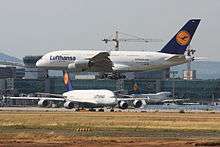
Frankfurt Airport is one of the busiest airports in the world and is also the single largest place of work in Germany with over 500 companies which employ 71,500 people (2010).[54]
Lufthansa
The largest employer at Frankfurt Airport is Lufthansa, Germany's flag carrier and Europe's largest airline. Lufthansa employs 35,000 people in Frankfurt.[55][56] The Lufthansa Aviation Center (LAC) is the main operation base of Lufthansa at Frankfurt Airport. The airport serves as Lufthansa's primary hub with 157 worldwide destinations (compared to 110 destinations at Munich Airport, Lufthansa's second-largest hub). Lufthansa Cargo is based in Frankfurt and operates its largest cargo center (LCC) at Frankfurt Airport. Lufthansa Flight Training is also based here.
Fraport
Fraport is the owner and operator of Frankfurt Airport. It is the airport's second-largest employer (19,800 workers in 2010).[57] Fraport also operates other airports worldwide, e.g., King Abdulaziz International Airport in Jeddah, Jorge Chávez International Airport in Lima and Antalya Airport.
Condor
Condor is a German airline and part of Thomas Cook Group, based at Frankfurt Airport.
Other industries
Accountancy and professional services
Three of the four largest international accountancy and professional services firms (Big Four) are present.
PricewaterhouseCoopers (PwC) German headquarters are located at Tower 185. KPMG moved its European Headquarters (KPMG Europe LLP) to The Squaire. Deloitte Touche Tohmatsu are present, while Ernst & Young is located in Eschborn.
Credit rating agencies
The three major international credit rating agencies – Standard & Poor's, Moody's and Fitch Ratings – have their German headquarters in Frankfurt.
Investment trust companies
DWS Investments is the largest investment trust company in Germany and manages €288 billion fund assets. It is one of the 10 largest investment trust companies in the world.[58] Other large investment trust companies are Allianz Global Investors Europe (a division of Allianz SE, and a top-five global active investment manager with €1,933 billion assets under management globally), Union Investment and Deka Investmentfonds.
Management consultancies
Many of the largest international management consultancies are represented, including Arthur D. Little, McKinsey & Company, Boston Consulting Group, Booz & Company, Oliver Wyman, Bearing Point, Capgemini, Bain & Company and Roland Berger Strategy Consultants.
Real estate services companies
Located in Frankfurt are the German headquarters of Jones Lang LaSalle and BNP Paribas Real Estate.
Law firms
Frankfurt has the highest concentration of lawyers in Germany, with one lawyer per 97 inhabitants (followed by Düsseldorf with a ratio of 1/117 and Munich with 1/124) in 2005.[59]
Most of the large international law firms maintain offices, among them Allen & Overy, Baker & McKenzie, Bird & Bird, Clifford Chance, Cleary Gottlieb Steen & Hamilton, Debevoise & Plimpton, DLA Piper, Freshfields Bruckhaus Deringer, Hogan Lovells, Jones Day, Latham & Watkins, Linklaters, Mayer Brown, Milbank, Tweed, Hadley & McCloy, Norton Rose, Shearman & Sterling, Sidley Austin, SJ Berwin, Skadden, Arps, Slate, Meagher & Flom, Sullivan & Cromwell, K&L Gates, Taylor Wessing and White & Case.
Advertising agencies
Although it is best known for its banks and financial institutions, Frankfurt is also a centre for media companies. Around 570 companies of the advertising industry and 270 public relations companies are there.
According to a ranking of German FOCUS magazine (November 2007) seven of the 48 largest advertising agencies in Germany are based in Frankfurt, including McCann-Erickson, Saatchi & Saatchi, JWT, and Publicis.[60]
Food
Frankfurt is home to the German headquarters of Nestlé, the world's largest food company, located in Niederrad. Other important food companies are Ferrero SpA (German headquarters) and Radeberger Gruppe KG, the largest private brewery group in Germany.
Automotive
The South-Korean automobile manufacturer Kia Motors moved its European headquarters to Frankfurt in 2007. In the same year Italian manufacturer Fiat opened its new German headquarters. The automotive supplier Continental AG has the headquarters and a major manufacturing plant of its Chassis & Safety division (formerly ITT Automotive) located in Frankfurt Rödelheim.
Construction
Some of the largest German construction companies have offices, e.g., Bilfinger Berger, Hochtief, Züblin and BAM Deutschland.
Property and real estate
Frankfurt has Germany's highest concentration of homeowners. This is partly attributed to the financial sector, but also to its cosmopolitan nature, with expatriates and immigrants representing one fourth of its population. For this reason Frankfurt's property market often operates differently than the rest of the country where the prices are generally flatter.
Other

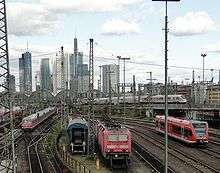
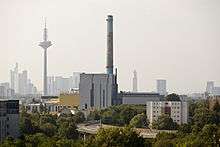
Frankfurt is home to companies from the chemical, the transportation, the telecommunication and the energy industry. Some of the larger companies are:
- Industriepark Höchst — An industrial park in Höchst. It is one of Germany's largest with over 90 companies from the pharmaceutical, the chemical and the biotechnology industry, including Celanese, Clariant, BASF, Merck KGaA and Siemens. It was founded by chemical company Hoechst AG in 1874. At the beginning of the 1980s Hoechst AG was the largest pharmaceutical corporation and Industriepark Höchst was known as "the pharmacy of the world". Hoechst AG merged with Rhône-Poulenc to become Aventis in 1999 and in 2004 Aventis merged with Sanofi-Synthélabo to become Sanofi-Aventis. In 2005, around 22,000 people worked at Industriepark Höchst. In 2011, Ticona now part of Celanese, an international manufacturer of engineering polymers, moved to Industriepark Höchst.
- Deutsche Bahn — Deutsche Bahn subsidiaries DB Fernverkehr, DB Regio, DB Stadtverkehr, DB Netz, DB Schenker and the corporate development department of Deutsche Bahn are Frankfurt-based.
- Deutsche Telekom — Deutsche Telekom's subsidiary T-Systems is Frankfurt-based.
- COLT — Telecommunications company with Frankfurt-based German headquarters.
- Level 3 Communications — internet service provider with German headquarters based in Frankfurt.
- DE-CIX — Frankfurt is an important location for electronic communication, especially the Internet. It is home to DE-CIX, the world's largest internet exchange point, and also the place where domain names are registered for top-level-domain ".de".
- Mainova — The largest regional energy supplier in Germany with about one million customers in Hesse. It provides electricity, gas, heat and water. Its headquarters are Frankfurt-based.
Urban area (suburban) businesses
Within Frankfurt's urban area are several important companies.
The business centre of Eschborn is located right at Frankfurt's city limits in the west and attracts businesses with significantly lower corporate taxes compared to Frankfurt. Major companies in Eschborn include Ernst & Young, Vodafone Germany, Randstad Holding and VR Leasing. Deutsche Börse moved most of its employees to Eschborn in 2010.
Rüsselsheim is internationally known for its automobile manufacturer Opel, one of the biggest automobile manufacturers in Germany. With 20,000 employees in 2003, Opel was one of the five largest employers in Hesse.
Offenbach am Main is home to the European headquarters of automobile manufacturer Hyundai Motor Company, to the German headquarters of automobile manufacturer Honda, to Honeywell Germany and to Deutscher Wetterdienst, the central scientific agency that monitors weather and meteorological conditions over Germany.
Two DAX companies are located in Bad Homburg vor der Höhe, Fresenius SE & Co. KGaA and Fresenius Medical Care. Other major companies are Hewlett-Packard, Bridgestone, Deutsche Leasing and Basler Versicherungen.
Kronberg im Taunus is home of the German headquarters of automobile manufacturer Jaguar Cars as well as the German headquarters of Accenture.
Lufthansa Systems, a subsidiary of Lufthansa, is located in Kelsterbach.
LSG Sky Chefs, another subsidiary of Lufthansa, is located in Neu-Isenburg.
The German headquarters of Thomas Cook Group are based in Oberursel (Taunus).
Langen is home to Deutsche Flugsicherung, the German air traffic control.
Quality of life

According to a ranking list (2001) produced by the University of Liverpool, Frankfurt is the richest city in Europe by GDP per capita, followed by Karlsruhe, Paris and Munich.[61]
Frankfurt was voted the 7th in the Mercer Quality of Living Survey by the Mercer Quality of Living Survey (2012),[62] seventh in the Mercer Quality of Living Survey (2010) and 18th at the Economist's World's Most Liveable Cities Survey (2011).[63] According to an annual citizen survey (2010), arranged by the city council, 66 percent inhabitants are satisfied or highly satisfied with the city, while only 6 percent said that they are dissatisfied. Compared to the 1993's survey the number of satisfied inhabitants has grown about 22 percent while the number of dissatisfied inhabitants was reduced by 8 percent. 84 percent of the inhabitants like to live in Frankfurt, 13 percent would rather choose to live somewhere else. 37 percent are satisfied with the public safety (1993: only 9 percent), 22 percent are dissatisfied (1993: 64 percent).[64]
Frankfurt consistently has the highest levels of crime per 100,000 inhabitants in Germany (15.976 crimes per annum in 2008) and is therefore dubbed the German "crime capital".[65] However, this statistic is often criticized because it ignores major factors: It is calculated based on the administrative 680,000-inhabitant figure while the urban area has 2.5 M inhabitants and on weekdays adds another million people (not counting the 53 million passengers passing through the airport each year). The rate for personal safety-relevant crimes such as murder, manslaughter, rape or bodily harm, is 3.4 percent, placing Frankfurt twelfth in the ranking (related to the official 680,000-inhabitant figure) or number 21 (related to the one-million-figure).[66]
Governmental institutions
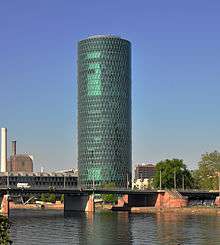
European Insurance and Occupational Pensions Authority
The European Insurance and Occupational Pensions Authority (EIOPA) is an institution of the European Union and part of the European System of Financial Supervisors that was created in response to the financial crisis. It was established on 1 January 2011.
Federal Financial Supervisory Authority
Frankfurt is one of two locations of the German Federal Financial Supervisory Authority (Bundesanstalt für Finanzdienstleistungsaufsicht, short: BaFin). The BaFin is an independent federal institution and acts as Germany's financial regulatory authority.
International Finance Corporation
Frankfurt is home to the German office of the International Finance Corporation (IFC), which is part of the World Bank Group. The IFC promotes sustainable private sector investment in developing countries.
German National Library
Frankfurt is one of two sites of the German National Library (Deutsche Nationalbibliothek), the other being Leipzig. The Deutsche Nationalbibliothek is the largest universal library in Germany. Its task, unique in Germany, is to collect, permanently archive, comprehensively document and record bibliographically all German and German-language publications from 1913 on, foreign publications about Germany, translations of German works and the works of German-speaking emigrants published abroad between 1933 and 1945, and to make them available to the public.
Trade unions and associations

Frankfurt is home to multiple trade unions and associations, including:
- IG Metall, Germany's largest metalworkers trade union, based at the Main Forum high-rise building in the Gutleutviertel district
- IG Bauen-Agrar-Umwelt, a union for construction and engineering workers,
- Gewerkschaft Erziehung und Wissenschaft, a union for teachers
- Gewerkschaft Deutscher Lokomotivführer, a union for train drivers
trade associations include:
- Verband der Elektrotechnik, Elektronik und Informationstechnik (Electrotechnical, Electronic and Information Technology Association)
- DECHEMA Gesellschaft für Chemische Technik und Biotechnologie (Applied Chemistry and Biotechnology Association)
- Börsenverein des Deutschen Buchhandels (German Booksellers Association), which organises the Frankfurt Book Fair
- Bundesverband des Deutschen Versandhandels (German Catalogue Selling Association)
- Verband der Chemischen Industrie (Chemical Industry Association)
- Verband der Photoindustrie (Photography Industry Association)
- Verband Deutscher Maschinen- und Anlagenbau (German Machine and Equipment Building Association)
- Verband der Köche Deutschlands (German Cooks Association)
Tourism
Sights
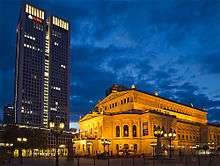
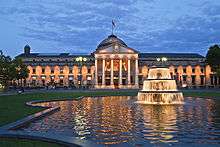

Frankfurt is one of Germany's leading tourist destinations. In addition to its infrastructure and economy, its diversity supports a vibrant cultural scene. This blend of attractions led 4.3 million tourists (2012) to visit Frankfurt.[67] The Hotels in central Frankfurt offer 34,000 beds in 228 hotels, of which 13 are luxury hotels and 46 are first-class hotels.[68]
Sights in the Frankfurt Rhein-Main-Area
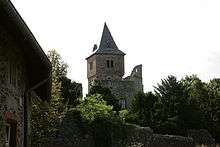
Besides the tourist attractions in central Frankfurt many internationally famous sites are within 80 km (50 mi) of the city, such as:
North
- Taunus mountain range
- Roman Empire Army Camp Saalburg
- Limes (former northern border of the Roman Empire)
- Bad Homburg vor der Höhe with its famous casino
- Bad Nauheim Elvis Presley memorial
- Hessenpark
West
- Wiesbaden with its Kurhaus, State Theater, Neroberg and Casino
- Rüdesheim
- Rheingau
- Eberbach Monastery (the original movie set of the film The Name of the Rose)
- Rhine Valley
- River Rhine
- Rheinhessen (wine region)
East
- Leather Museum Offenbach
- Hanau Grimm Brothers Summer Festival
- German Fairy Tale Route
- Spessart
South
- Darmstadt with the Art Nouveau Mathildenhoehe
- Waldspirale and the
- The former private chapel of the last Tsar of Russia
- Vortex Garden
- Odenwald
- Bergstrasse
- Vineyards at Heppenheim
- Frankenstein Castle
- Heidelberg
Consulates
As a profoundly international city, Frankfurt hosts 92 diplomatic missions (consulates and consulates-general). Worldwide, only New York City and Hamburg are non-capital cities with more foreign representation. The Consulate General of the United States in Eckenheim is the largest American consulate in the world.
Courts
Several courts are located in Frankfurt, including:
- Hessisches Landesarbeitsgericht (Hessian State Employment Court)[69]
- Oberlandesgericht Frankfurt (Higher Regional Court Frankfurt)[70]
- Landgericht Frankfurt (Regional Court Frankfurt)[71]
- Amtsgericht Frankfurt (Local Court Frankfurt)[72]
- Sozialgericht Frankfurt (Social Court Frankfurt)[73]
- Arbeitsgericht Frankfurt (Employment Court Frankfurt)[74]
- Verwaltungsgericht Frankfurt (Administration Court Frankfurt)[75]
Media
Newspapers
Two important daily newspapers are published. The conservative Frankfurter Allgemeine Zeitung, also known as FAZ, was founded in 1949 and is the German newspaper with the widest circulation outside of Germany, with its editors claiming to deliver the newspaper to 148 countries every day. The FAZ has a circulation of over 380,000 copies daily. The other important newspaper, the Frankfurter Rundschau, was first published in 1945 and has a daily circulation of over 181,000.
Magazines
Several magazines also originate from Frankfurt. The local Journal Frankfurt is the best-known magazine for events, parties, and "insider tips". Öko-Test is a consumer-oriented magazine that focuses on ecological topics. Titanic is a well-known and often criticized satirical magazine with a circulation of approximately 100,000.
Radio and TV
Frankfurt's first radio station was the Südwestdeutsche Rundfunkdienst AG (Southwest German Broadcast Service), founded in 1924. Its successor service is the public broadcaster Hessischer Rundfunk (Hessian Broadcast Service). It is located at the "Funkhaus am Dornbusch" in the Dornbusch district and is one of the most important radio and television broadcasters in Hesse, with additional studios in Kassel, Darmstadt and Fulda.
Bloomberg TV and RTL Television have regional studios.
Other radio broadcasters include Main FM and Radio X.
From August 1945 to October 2004, the American Forces Network (AFN) had broadcast from Frankfurt. Due to troop reductions the AFN's location has been closed with AFN now broadcasting from Mannheim.
News agency
Frankfurt is home to the German office of Reuters, the global news agency.
Education and research
Frankfurt hosts two universities and several specialist schools. The two business schools are Goethe University Frankfurt's Goethe Business School and Frankfurt School of Finance & Management.
Johann Wolfgang Goethe University
The oldest and best-known university is the Johann Wolfgang Goethe University, with locations in Bockenheim, Westend, and Riedberg, and the university hospital in Niederrad. Goethe Business School is part of the University's House of Finance at Campus Westend. The Business School's Full Time MBA program has over 70% international students.
Frankfurt University of Applied Sciences
The Frankfurt University of Applied Sciences was created out of several older organisations in 1971, and offers over 38 study areas, in the arts, sciences, engineering and law. Some of the most important research projects: Planet Earth Simulator, FraLine-IT-School-Service, quantitative analysis of methane in human corpses with the help of a mass spectrometer, software engineering (e.g., fraDesk), analysis of qualitative and quantitative gas in human lungs, long-term studies on photovoltaic modules (to name only a few).
Frankfurt School of Finance & Management
Alongside the university is the banking academy Frankfurt School of Finance & Management, formerly known as the Hochschule für Bankwirtschaft (Institution of Higher Learning for Banking Economics), with its campus in the Ostend (Eastend) neighbourhood. In 2001, it became a specialist institution for Economics and Management, or FOM.
Städelschule
Frankfurt has the State Institution of Higher Learning for Artistic Education known as the Städelschule, founded in 1817 by Johann Friedrich Städel. It was taken over by the city in 1942 and turned into a state art school.
Music schools and conservatory
Music institutions are the Frankfurt University of Music and Performing Arts, and the Hoch Conservatory (Dr. Hoch's Konservatorium) which was founded in 1878. The International Ensemble Modern Academy is a significant institution for the study of contemporary music.[76]
Other notable schools
The Philosophical-Theological Institution of Saint George (Philosophisch-Theologische Hochschule Sankt Georgen), a private institution with membership in the German Jesuit Association, has been located in Sachsenhausen since 1950.
The city is home to three Max Planck Society institutes: the Max Planck Institute for European History of Law (MPIeR), Max Planck Institute for Biophysics, and the Max Planck Institute for Brain Research.
The Frankfurt Institute for Advanced Studies, sponsored by several institutional and private sources, is involved in theoretical research in physics, chemistry, neuroscience, and computer science.
Frankfurt is host to the Römisch-Germanische-Kommission (RGK), the German Archaeological Institute branch for prehistoric archaeology in Germany and Europe. The RGK is involved in a variety of research projects. Its library, with over 130,000 volumes, is one of the largest specialised archaeological libraries in the world.
Education and media
Frankfurt schools rank among the best equipped schools nationwide for availability of PCs and other media facilities. In order to assure maintenance and support of the school PCs, the city in cooperation with the University of Applied Sciences launched the project Fraline – IT-Schul-Service, an initiative employing students to provide basic school IT-support.
Sports
Frankfurt is home to several professional sports teams. Some of them have won German Championships. E.g. the Skyliners Frankfurt won the German Basketball Championship in 2004 and the German Cup in 2000. Frankfurt hosts the following sports teams or clubs:
|
|
Frankfurt is host to the classic cycle race Eschborn-Frankfurt City Loop (known as Rund um den Henninger-Turm from 1961 to 2008). The city hosts also the annual Frankfurt Marathon and the Ironman Germany.
Further reading
History
- Kramer, Waldemar (Hrsg.): Frankfurt Chronik. Verlag Waldemar Kramer, Frankfurt am Main 1987 (3. Auflage), ISBN 3-7829-0321-8.
- Lothar Gall (Hrsg.): FFM 1200. Traditionen und Perspektiven einer Stadt. Jan Thorbecke Verlag, Sigmaringen 1994, ISBN 3-7995-1203-9 (Katalog zur 1200-Jahrfeier 1994 mit wiss. Aufsätzen).
- Mack, Ernst: Von der Steinzeit zur Stauferstadt. Die frühe Geschichte von Frankfurt am Main. Verlag Josef Knecht, Frankfurt am Main 1994, ISBN 3-7820-0685-2.
Architecture
- Schohmann, Heinz: Frankfurt am Main und Umgebung. Von der Pfalzsiedlung zum Bankenzentrum. Dumont Kunstreiseführer. Dumont, Köln 2003, ISBN 3-7701-6305-2. (mit Schwerpunkt Architektur).
- Bodenbach, Christoph (Hrsg.): Neue Architektur in Frankfurt am Main. Junius Verlag, Hamburg 2008, ISBN 978-3-88506-583-8.
- Sturm, Philipp, Schmal, Peter Cachola: Hochhausstadt Frankfurt. Bauten und Visionen seit 1945, Prestel, München 2014, ISBN 978-3-7913-5363-0.
Others
- Setzepfandt, Christian: Geheimnisvolles Frankfurt am Main. Wartberg, Gudensberg-Gleichen 2003, ISBN 3-8313-1347-4.
- Mosebach, Martin: Mein Frankfurt. Mit Photographien von Barbara Klemm. Insel, Frankfurt am Main 2002, ISBN 3-458-34571-X. (Insel-Taschenbuch. Bd 2871)
See also
References
Notes
- A. ^ Topped out but not completed.
Citations
- ↑ "Bevölkerung der hessischen Gemeinden". Hessisches Statistisches Landesamt (in German). August 2016.
- 1 2 Regional Authority FrankfurtRheinMain - Facts and figures Retrieved 3 November 2014
- 1 2 Regional monitoring 2012, German metropolitan regions
- 1 2 "Bevölkerung der Hessischen Gemeinden". Statistik-Hessen.de. 30 September 2015. Retrieved 9 April 2016.
- 1 2 European Union: State of European Cities Report Retrieved 22 April 2014
- 1 2 Internetredaktion (23 May 2012). "Bundesbank: Bankenplatz Frankfurt" (PDF) (in German). Bundesbank.de.
- ↑ "The World According to GaWC". GaWC. Retrieved 4 November 2014.
- ↑ Bahnhof.de Frankfurt Hbf. Retrieved 27 September 2011.
- ↑ Strassenwaerter Archived 2 May 2005 at the Wayback Machine.
- ↑ "Mercer's Survey 2011". Mercer. 29 November 2011.
- ↑ "World's most expensive place to live is...". The Economist.
- ↑ Dovid Solomon Ganz, Tzemach David (part 2), Warsaw 1859, p. 13b (Hebrew); Polish name of book: Cemahc Dawid; cf. J.M. Wallace-Hadrill, Fredegar and the History of France, University of Manchester, n.d. pp. 536-538.
- ↑ Room, Adrian (2006). Placenames of the world. McFarland. p. 135. ISBN 978-0-7864-2248-7. Retrieved 23 July 2009.
- ↑ Chronology: Emergence of a Modern City 1866–1945. Retrieved 10 June 2010.
- ↑ "French march into Germany". The Times. 7 April 1920. p. 10. "The French commander issued a notice to the public informing them that the occupation was consequent upon the German advance in the Ruhr contrary to the Peace Treaty."
- ↑ Stanton, Shelby, World War II Order of Battle: An Encyclopedic Reference to U.S. Army Ground Forces from Battalion through Division, 1939–1946 (Revised Edition, 2006), Stackpole Books, p. 57, 84.
- ↑ Goitein, S.D. A Mediterranean Society: The Jewish Communities of the Arab World as Portrayed in the Documents of the Cairo Geniza, Vol. I – Economic Foundations. University of California Press, 2000, p. 5
- ↑ "Stadtteile". Frankfurt.de.
- ↑ "Ausgabe der Klimadaten: Monatswerte".
- ↑ "Statistisches Bundesamt Deutschland – Neue Daten zur Migration in Deutschland verfügbar". Destatis.de. 20 October 2008. Retrieved 8 April 2011.
- ↑ H. Voit, Die kommunale Gebietsreform in: Erwin Stein (Hrsg.): 30 Jahre Hessische Verfassung, Wiesbaden 1976, p. 416 ff. (Text in German)
- ↑ "Statistisches Jahrbuch Frankfurt am Main" (PDF). Stadt Frankfurt am Main. Retrieved 19 July 2014.
- ↑ "Statistisches Jahrbuch Frankfurt am Main 2009" (PDF).
- 1 2 3 "Statistisches Jahrbuch Frankfurt am Main 2010" (PDF).
- ↑ "50 JAHRE NUUR-MOSCHEE". 3 October 2009. Retrieved 8 June 2014.
- ↑ "Frankfurter Statistisches Jahrbuch 2014, Kapitel 2: Bevölkerung" (PDF). Retrieved 20 June 2015.
- ↑ "Muslime in Frankfurt am Main – Ergebnisse einer Schätzung" (PDF). Retrieved 20 June 2015.
- ↑ "Jüdische Gemeinde Frankfurt - Wir über uns". Retrieved 20 June 2015.
- ↑ "Eskişehir – Sister Cities". [[copyright|]] 2011 Eskişehir Metropolitan Municipality. Retrieved 18 February 2014.
- ↑ "Canada–Germany: Institutions and Organizations". canadainternational.gc.ca.
- ↑ "Kraków - Miasta Partnerskie" [Kraków -Partnership Cities]. Miejska Platforma Internetowa Magiczny Kraków (in Polish). Archived from the original on 2 July 2013. Retrieved 10 August 2013.
- ↑ Robertson, Staun. "Zyklon B Poison Gas". A History of Jews in Hamburg. University of Hamburg. Archived from the original on 22 February 2008.
- ↑ "Poelzig Building / Westend Campus". Historical Frankfurt. Tourismus+Congress GmbH.
- ↑ [http://www.frankfurt.de/sixcms/detail.php?id=2855&_ffmpar[_id_inhalt]=7187755 "Auf dem Weg zur Green City"]. Frankfurt.de.
- ↑ "Neue Ehrlichkeit. Mit Tanzmusik aus dem Computer feign zwei Frankfurter Klangbastler weltweit Erfolge." (PDF). Der Spiegel (in German). Hamburg. 3 October 1994. p. 268. Retrieved 7 March 2016.
- ↑ "Opernwelt Pressemitteilung". Kultiversum.de.
- ↑ Cocoon Club droht die Schließung, http://www.spiegel.de, 1 November 2012 {{{2}}}
- ↑ http://www.fr-online.de/frankfurt/clubs--living-xxl-geschlossen,1472798,24603930.html
- ↑ http://www.journal-frankfurt.de/journal_news/Nightlife-103/Kultclub-im-Japan-Center-nur-noch-bis-Jahresende-Club-101-schliesst-nach-13-Jahren-28122.html
- ↑ http://www.extratipp.com/rhein-main/club-monza-frankfurt-schliesst-abschied-party-april-2787439.html
- ↑ "High-speed trains to link England and Germany". Brisbanetimes.com.au. 16 October 2011. Retrieved 16 May 2012.
- ↑ "Rhein-Main Transport Association". RMV.DE. 24 November 2010. Retrieved 10 April 2011.
- ↑ "Nightbus Frankfurt Rheinmain". Nachtbus-frankfurt.de. Retrieved 10 April 2011.
- ↑ "Uber Pulls Out Of Three German Cities After Court Ban Shrinks Driver Pool".
- ↑ "Call a Bike: Startseite". callabike-interaktiv.de.
- ↑ 36.31.5, Stadt Frankfurt am Main - Der Oberbürgermeister - Straßenverkehrsamt Radfahrbüro. "Radfahrbüro der Stadt Frankfurt". www.radfahren-ffm.de. Retrieved 5 September 2015.
- ↑ "The Global Financial Centres Index 12.5" (PDF). Long Finance. January 2013.
- ↑ Innovation Cities Index 2011 Archived 22 April 2012 at the Wayback Machine.
- ↑ Kearney, Inc., A.T. "The 2012 Global Cities Index". Foreign Policy.
- ↑ "ECM 2009v1:V1" (PDF).
- ↑ Beaverstock, J.V.; Smith, R.G.; Taylor, P.J. "The World According to GaWC 2010". Globalization and World Cities.
- ↑ "GaWC 2008". Lboro.ac.uk. 13 April 2010.
- ↑ "Größte Banken der Welt". Manager-magazin.de.
- ↑ Rolf Didszuns (21 October 2011). "Frankfurt-Interaktiv: Flughafen Frankfurt". Frankfurt-interaktiv.de.
- ↑ "Lufthansa-Konzernzentrale teurer als geplant". Focus.de. 18 July 2006.
- ↑ Report-k.de: Lufthansa-Verwaltung in Köln-Deutz eröffnet Archived 24 November 2007 at the Wayback Machine.
- ↑ "Personal in Zahlen". Fraport.de.
- ↑ DWS: Unternehmensprofil
- ↑ "Anwaltsdichte in Deutschland". Juraforum.de.
- ↑ "FOCUS: Die größten Werbeagenturen 2007" (PDF). Archived from the original on 27 February 2008. Retrieved 2007-12-03.
- ↑ Nick Swift: European cities outperform their English counterparts. citymayors.com (Zugriff am 1. November 2006)
- ↑ "Global Cities Survey 2011". Knightfrank.com.
- ↑ "FR-Online: Frankfurt ist zweitattraktivste Stadt Deutschlands" (in German). Fr-online.de.
- ↑ "Frankfurt.de: Statistik aktuell Nr. 8/2011" (PDF).
- ↑ Source: Polizeiliche Kriminalstatistik 2008
- ↑ "Frankfurt.de: Kriminalitätsstatistik 2009" (PDF).
- ↑ frankfurt-tourismus.de Gäste- und Übernachtungszahlen 2012. Retrieved 24 July 2013.
- ↑ Frankfurt - Data, Facts, Figures Retrieved 23 April 2014
- ↑ https://lag-frankfurt-justiz.hessen.de/irj/LAG_Hessen_Internet
- ↑ (German) Website of the Higher Regional Court
- ↑ (German) Website of the Regional Court
- ↑ https://ag-frankfurt-justiz.hessen.de/irj/AMG_Frankfurt_Internet
- ↑ https://sg-frankfurt-justiz.hessen.de/irj/SG_Frankfurt_am_Main_Internet
- ↑ https://arbg-frankfurt-justiz.hessen.de/irj/ArbG_Frankfurt_am_Main_Internet
- ↑ https://vg-frankfurt-justiz.hessen.de/irj/VG_Frankfurt_am_Main_Internet
- ↑ "International Ensemble Modern Academy". internationale-em-akademie.de.
External links
| Wikimedia Commons has media related to Frankfurt am Main. |
| Wikivoyage has a travel guide for Frankfurt. |
| Wikisource has the text of the 1911 Encyclopædia Britannica article Frankfort-on-Main. |
- Architecture of Frankfurt
- Frankfurt Zoo (English)
- Frankfurt before and after World War II
- Frankfurt webcam links
- Frankfurt photogallery
- Visual Frankfurt
- Frankfurt Panoramas: 360°City Panoramas Panorama-cities.net; Panorama Frankfurt – Bilder von der Skyline Oopper.de; frankfurt360.de, panorama-frankfurt.de
-
 "Frankfort-on-the-Main". The American Cyclopædia. 1879.
"Frankfort-on-the-Main". The American Cyclopædia. 1879.
-
 "Frankfort-on-the-Main". Collier's New Encyclopedia. 1921.
"Frankfort-on-the-Main". Collier's New Encyclopedia. 1921. - Tourismus+Congress GmbH Frankfurt am Main
- Frankfurt am Main at DMOZ
- Cultural portal of the city of Frankfurt am Main
- There is literature about Frankfurt in the Hessian Bibliography
 |
Koblenz, Bonn, Cologne | Marburg, Gießen | Fulda |  |
| Wiesbaden | |
Würzburg | ||
| ||||
| | ||||
| Kaiserslautern, Saarbrücken | Darmstadt, Mannheim, Karlsruhe, Stuttgart | Nuremberg |


.jpg)

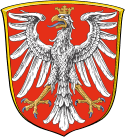



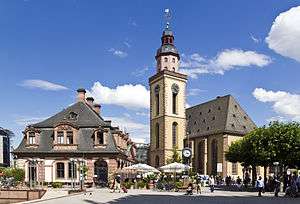

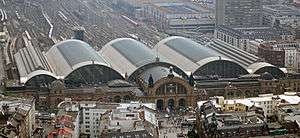

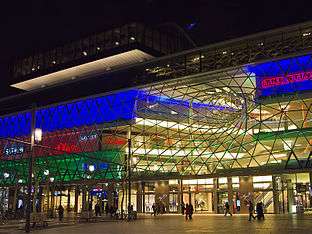


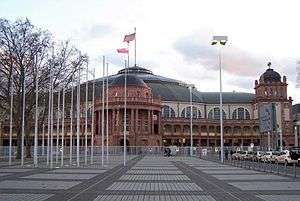
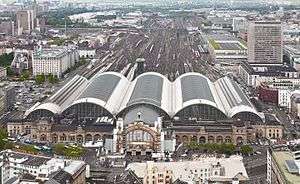

_(7954668126).jpg)